Off to Xinjiang
Today I am going with the Yale students who are in the Beijing program to Xinjiang, the westernmost province of China. (Or to be strictly correct: autonomous region). We are visiting several exciting places, like Ürümqi, Turpan, and Kashi (Kashgar). This will be fun. I do not know when I next will be able to update the blog, but I surely will get a lot of photos while I am there.
Happy report
This morning I was happily surprised by an email in my inbox. Yale University Press has sent out my finished book manuscript to two scholars for peer review, and now I received the report from one of them. The reports are anonymous, so I have no idea who wrote it. I was still very happy that the report was almost embarrassingly positive. It seems that I have succeeded in what I have been trying to do with this book, at least as far as this scholar is concerned. Now I hope for a second report that is at least a fraction as positive as this one.
Lunch at Chinese fast food place Saturday
Before I fell sick, I went with Ningping to meet a former student in the Yale-PKU program, Eleni, to have lunch. We went to a Chinese fastfood place called "Steamed Kung Fu". The food was very good. I had "steamed chicken." This turned out to be chicken in a pot of bouillon. Very good. A chicken foot was in the pot!
Eleni was pleasant to speak with. She has stayed in China over the summer to teach English to 12-year-olds in Tianjin, but is soon going back to the States and New Haven.
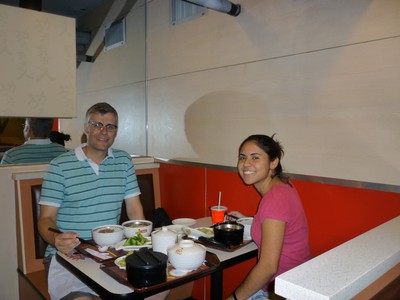
Eleni was pleasant to speak with. She has stayed in China over the summer to teach English to 12-year-olds in Tianjin, but is soon going back to the States and New Haven.

Monday: work day after a slightly troubled weekend
So I mostly stayed at home, and partially in bed Sunday, for I came down with a cold. I was very hoarse and coughed a lot. Wonderful Ningping got me some cough syrup and some Chinese pills that I do not know what they are, or what they are supposed to do specifially. I felt much better after a long nap in the afternoon. Then I, for once, took a sleeping pill for the night, went to bed early, slept for ten hours and woke up feeling almost entirely recuperated. So today I have gone in to the office as usual.
Xiaojie was not at the office today, for she was at the airport meeting the Yale students who are arriving today to join the program. I have been preparing all day. I had a lunch meeting with one of my two teaching assistants, Qianyi, who will help me with the Eurasian Encounters course. She speaks really good English, seems really smart and enthusiastic, so I think we will have a good experience teaching this course together. She gave me a book, Chinese
Characteristics, by Arthur H. Smith. He was an American missionary (from Connecticut!) who lived for more than 50 years in Shandong province. The book seems great, and I look forward to reading it!
It is time to start thinking about packing for our excursion to Xinjian starting Wednesday. I will have to leave home at about 6 to get to the bus that takes us to the airport for a flight to Western China. Fortunately, Ningping lives across the hallway from me, so we can walk together. We'll stay there until Monday of next week. This will be very exciting!
And that will surely produce some pictures. I am sorry that there has been so few pictures the last few days. I have mostly been working, so not much of interest to photograph.
Xiaojie was not at the office today, for she was at the airport meeting the Yale students who are arriving today to join the program. I have been preparing all day. I had a lunch meeting with one of my two teaching assistants, Qianyi, who will help me with the Eurasian Encounters course. She speaks really good English, seems really smart and enthusiastic, so I think we will have a good experience teaching this course together. She gave me a book, Chinese
Characteristics, by Arthur H. Smith. He was an American missionary (from Connecticut!) who lived for more than 50 years in Shandong province. The book seems great, and I look forward to reading it!
It is time to start thinking about packing for our excursion to Xinjian starting Wednesday. I will have to leave home at about 6 to get to the bus that takes us to the airport for a flight to Western China. Fortunately, Ningping lives across the hallway from me, so we can walk together. We'll stay there until Monday of next week. This will be very exciting!
And that will surely produce some pictures. I am sorry that there has been so few pictures the last few days. I have mostly been working, so not much of interest to photograph.
Fredag: mest lektionsplanering
I have no idea why this is in Swedish; that is just how it came out when I was tired late at night.
Fast i morse steg jag upp tidigt nog för att vara tvättad och frukosterad och klar när min städerska kom. Hon var extra tidig idag, halv nio. Fast straxt innan hon kom så kom de från hotellet som jag bor i (det är ju ett hotell som har avdelningar som är som lägenhetshotell) och bytte mina lakan i sängen. Skönt att sova i rena lakan! (Jag hade sagt till om detta).
Under dagen har jag sedan varit på jobbet och arbetat med min lektionsplanering för seminariet jag ska undervisa. Det är klart såtillvida som jag har ett fullt utkast som nog duger att distribuera i början av terminen till studenterna efter några smärre ändringar. Jag har också skickat det till min assistent. På kvällen gick jag och handlade. Roligt här att man kan köpa vin i matvaruaffärer. Så jag köpte en flaska vitt kinesiskt vin. Riktigt drickbart, men smaken är litet annorlunda mot vad man är van vid (liksom på rödvin). Kineserna oxiderar vinet, vilket man i Europa försöker undvika till varje pris. Smaken blir litet mer spetsig på det sättet. Så jag har suttit här och druckit litet vin medan jag arbetat på min andra lektionsplanering.
Nu ska jag lägga mig! Här är i alla fall den giraffe som Yongle-kejsaren av Kina fick från Africa 1415. Den hade åkt med Zheng He till Kina. Han är en av de figurer som vi ska studera i min kurs och jag har en bild liknande denna på lektionsplaneringen som studenterna ska få.
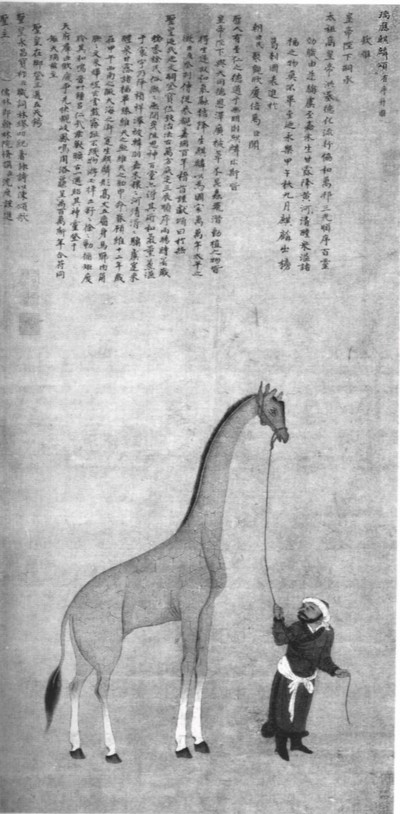
Fast i morse steg jag upp tidigt nog för att vara tvättad och frukosterad och klar när min städerska kom. Hon var extra tidig idag, halv nio. Fast straxt innan hon kom så kom de från hotellet som jag bor i (det är ju ett hotell som har avdelningar som är som lägenhetshotell) och bytte mina lakan i sängen. Skönt att sova i rena lakan! (Jag hade sagt till om detta).
Under dagen har jag sedan varit på jobbet och arbetat med min lektionsplanering för seminariet jag ska undervisa. Det är klart såtillvida som jag har ett fullt utkast som nog duger att distribuera i början av terminen till studenterna efter några smärre ändringar. Jag har också skickat det till min assistent. På kvällen gick jag och handlade. Roligt här att man kan köpa vin i matvaruaffärer. Så jag köpte en flaska vitt kinesiskt vin. Riktigt drickbart, men smaken är litet annorlunda mot vad man är van vid (liksom på rödvin). Kineserna oxiderar vinet, vilket man i Europa försöker undvika till varje pris. Smaken blir litet mer spetsig på det sättet. Så jag har suttit här och druckit litet vin medan jag arbetat på min andra lektionsplanering.
Nu ska jag lägga mig! Här är i alla fall den giraffe som Yongle-kejsaren av Kina fick från Africa 1415. Den hade åkt med Zheng He till Kina. Han är en av de figurer som vi ska studera i min kurs och jag har en bild liknande denna på lektionsplaneringen som studenterna ska få.

Torsdag
Today I had lunch, for the first time, with Tina and Stuart. We went with Xiaojie to a student dining hall. That was an experience. The area where one picked up food was absolutely crowded with people, and one had to squeeze oneself to the counter, where plates of food were standing waiting for a customer. I got a stirfry with vegetables and chicken (I think) and rice. When going from one part of the counter to another, I held my tray high up. Being rather taller than most Chinese, this worked rather well for me. In the end, I paid with my dining card at a cashier's desk. There was something like an orderly line for the cashier, as there was not otherwise.
We had a nice meal, and I liked my food.
Otherwise, I have spent my day working on my syllabus for the course on Eurasian Encounters. It is fun work.
Here are Xiaojie, Tina, and Stuart outside the dining hall.
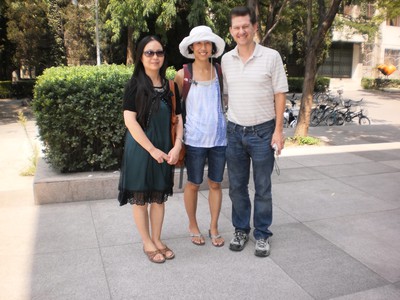
We had a nice meal, and I liked my food.
Otherwise, I have spent my day working on my syllabus for the course on Eurasian Encounters. It is fun work.
Here are Xiaojie, Tina, and Stuart outside the dining hall.

Sverige i Beijing

Tänkte försöka locka med detta så att jag får besök. Detta är längre ned på gatan Zhongguancun.
Work and a cough
I have not written much in the blog the last two days. There is not much to report. I have mainly been working, plus I have got a slight cough. Nothing much to worry about; in fact I am surprised how healthy I have been since I came to China. Flying in airplanes and starting to live in a new place usually means being sick, as the body gets used to the new fauna of bacteria and virus. But I have been perfectly healthy since I arrived, except for this slight cough.
I am working in parallel on two things: getting ready for the start of the semester and my book. Both are fun, but both are realy work. In my office, I am now done with getting the computer there set up so that I can easily use it (no viruses, my accoustomed email program, etc.). At home I am working on the book. My wonderful editor has suggested changes and written comments in the margins of a printout of the manuscript. So I am going through page after page. Most of the changes are so obviously good that I only need to put them into the computer version of the manuscript. Sometimes she asks me to reformulate something, and that takes me some more time and effort. But it is fun to see the book take shape.
I am working in parallel on two things: getting ready for the start of the semester and my book. Both are fun, but both are realy work. In my office, I am now done with getting the computer there set up so that I can easily use it (no viruses, my accoustomed email program, etc.). At home I am working on the book. My wonderful editor has suggested changes and written comments in the margins of a printout of the manuscript. So I am going through page after page. Most of the changes are so obviously good that I only need to put them into the computer version of the manuscript. Sometimes she asks me to reformulate something, and that takes me some more time and effort. But it is fun to see the book take shape.
Big waterbottle
One is not recommended to drink the water here, at least not if one has a sensitive European stomach. The program has an extra water cooler, which I get to borrow while I am here. The nice man who first repaired and cleaned it, then delivered it, is actually from Datong. We talked a little about what I saw there, mostly with Ningping as interpreter.
Now I have signed up for 11 bottles for the price of 10, which he will deliver as I need them. I will always have access to cold and hot clean water.
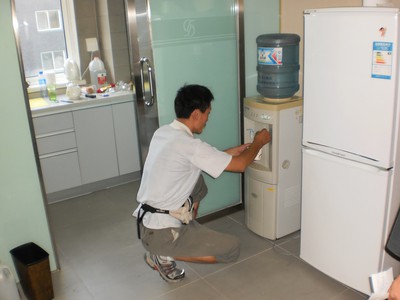
Now I have signed up for 11 bottles for the price of 10, which he will deliver as I need them. I will always have access to cold and hot clean water.

Food in Datong
It was interesting to eat in Datong. When I first arrived, I had my first dinner at the hotel. The menu was bilingual Chinese/English, as were to some degree the staff. But I did not much like the food, alas. Plus I woke up in the middle of the night with a bad headache, which may be a sign that the chef has been too enthusiastic with MSG.
So the next day, I tried a restaurant that I happened to pass in the street.

I was given a table and they sent forth a waitress who knew a little English. The menu was entirely in Chinese, so I could not really read it. But I asked in Chinese for diced chicken. I got what I asked for, but realized that I did not get any rice automatically. So I asked for that as well, plus a bottle of beer. All in Chinese, so I am proud that this was my first meal ordered entirely in Chinese, and it worked. The food was very good, and no headache during the night.

So I went back to the same place for my remaining two dinners. The second night, I ordered lamb, which also worked, and it tasted really good. The third night was more problematic. I tried to get noodles, but they did not serve that. So I tried dumplings (jaozi), but they did not have that either. Instead I got two steamed dumplings (baozi) with pork inside, and that was really good. I tried to get them with vegetables inside, but instead I got a plate of boiled vegetables, also very good.

All in all, this restaurant gave very good value. The meals were simple but very good, and I felt satisfied each night. That is why I came back. "My" waitress, whose name is 陈惠夏, Chen Hui Xia, was also very sweet and worked hard to understand what I said, and to provide good food.
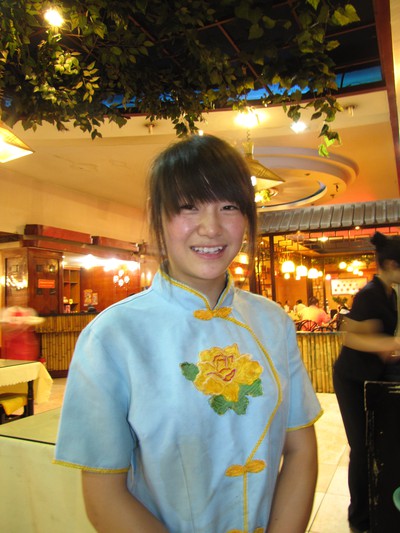
For lunch one day, I had meat grilled over charcoal on the street. This woman fanned the charcoal when she grilled my meat. It was tasty and good.

So the next day, I tried a restaurant that I happened to pass in the street.

I was given a table and they sent forth a waitress who knew a little English. The menu was entirely in Chinese, so I could not really read it. But I asked in Chinese for diced chicken. I got what I asked for, but realized that I did not get any rice automatically. So I asked for that as well, plus a bottle of beer. All in Chinese, so I am proud that this was my first meal ordered entirely in Chinese, and it worked. The food was very good, and no headache during the night.

So I went back to the same place for my remaining two dinners. The second night, I ordered lamb, which also worked, and it tasted really good. The third night was more problematic. I tried to get noodles, but they did not serve that. So I tried dumplings (jaozi), but they did not have that either. Instead I got two steamed dumplings (baozi) with pork inside, and that was really good. I tried to get them with vegetables inside, but instead I got a plate of boiled vegetables, also very good.

All in all, this restaurant gave very good value. The meals were simple but very good, and I felt satisfied each night. That is why I came back. "My" waitress, whose name is 陈惠夏, Chen Hui Xia, was also very sweet and worked hard to understand what I said, and to provide good food.

For lunch one day, I had meat grilled over charcoal on the street. This woman fanned the charcoal when she grilled my meat. It was tasty and good.

Dinner August 22
Ningping took her son Tommie and me to dinner further south in Haidan. It was a nice restaurant that served food in a special provincial style. We ordered several courses and were unable to eat everything we got.
The fish was very good, but hard to eat with chopsticks for me.
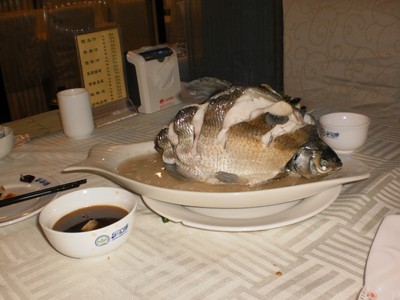
The duck was a little dry but was served with his head. Ningping told me that duck's head is considered a delicacy in southern China; in Nanjing, duck's head is more expensive than duck meat.
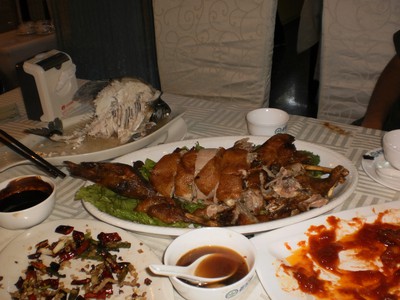
The fish was very good, but hard to eat with chopsticks for me.

The duck was a little dry but was served with his head. Ningping told me that duck's head is considered a delicacy in southern China; in Nanjing, duck's head is more expensive than duck meat.

Jag idag 22 augusti
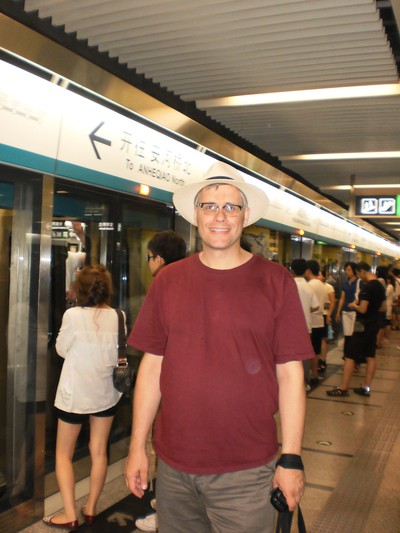
Bilden från Beijings tunnelbana, linje 4.
Skype med barnen
Idag pratade jag riktigt länge med Elsa och Hjalmar.
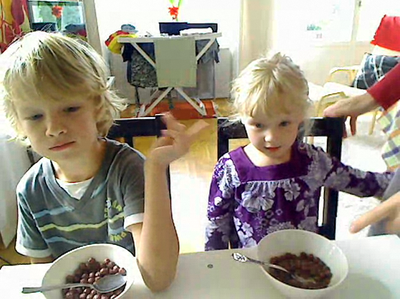
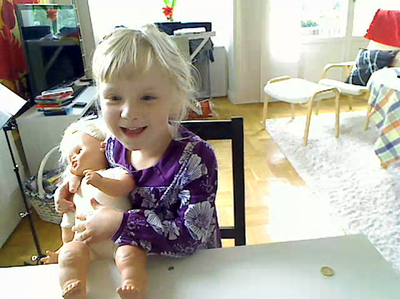


Datong city wall
In my old Baedeker from 1912, the map of Beijing still shows the old city wall, which is also mentioned in the text as something worth visiting. Its remnants were pulled down in and around the 50s to make way for one of the ring roads around Beijing. Only a small fragment of it survives, at the southeastern corner. I hope to visit this in the not too distant future.
Most of the old city wall remains in Datong. It is in rather poor shape, but it is being restored. Here are some photos of an unrestored piece of it just north of Xiangjiang Xijie. I am fascinated by all those doors into the wall. This would be on the outside, so I doubt that they are original. People must have dug chambers into the wall.

This picture is from where the wall has been broken to make way for the street.
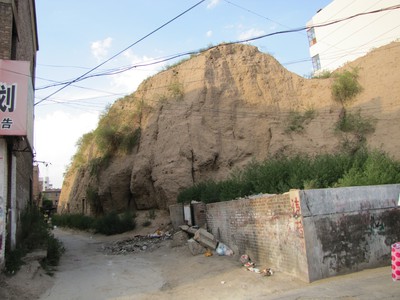
Also from the same place. At point just to the left of the top of the modern wall, I think one can see clearly that the wall was build in bricks.
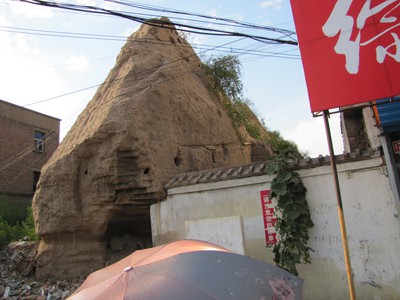
Later I spotted the wall towards the end of a back alley, so I walked down it, to find a garbage-strewn open place just inside the southwestern corner of the wall, and I got a closer look at the restoration works. At least from the inside I could not spot the tower that must once have defended this corner, but I have a feeling that it will be resurrected in the restoration.
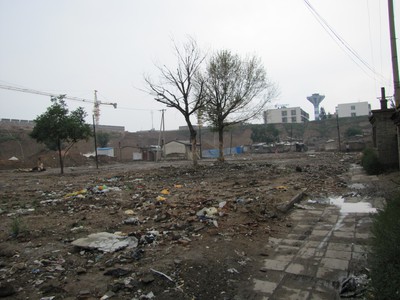
Zooming in, one can sort of see the outlines of the original bricks. I am sorry that I did not walk closer to get better pictures, but all the garbage and the puddles of that empty lot did not quite invite someone walking in sandals to get any further. Besides, there were three ragged wild dogs looking for food there. They showed no signs of being dangerous, indeed a couple of them ran past me, but still...
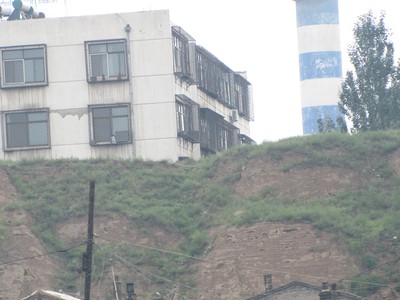
Here is a wooden watchtower being reconstructed.

You can guess at the method of reconstruction: A new surface of new bricks is built on the outside of the remnants of the original wall. Notice the long line of cranes for the reconstruction of the wall!
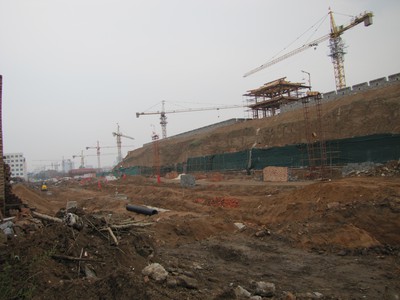
Another picture from the ongoing restoration works, this one from just south of the Southern monastery, next to what must have been the central southern gate.
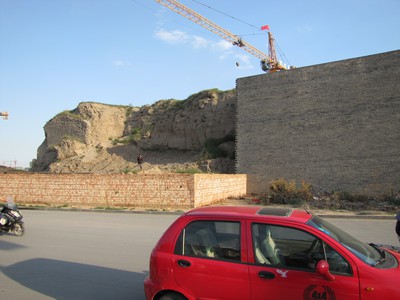
And finally some pictures from the almost finished restoration, on the east side of the city, at the eastern gate to which the Da Dongjie (Great Eastern Street) leads.

The great gate at the end of Da Dongjie.
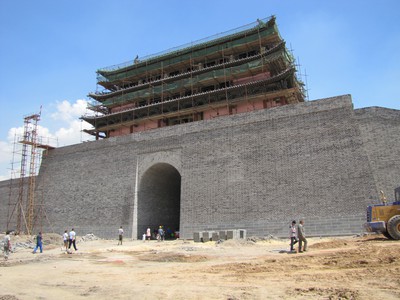
I walked in through the gate into a double barbicane.

Perhaps not constructed in the same way as the original.

My impression, but I am far from an expert, is that this restoration seems rather similar to those made by Viollet-Le-Duc in nineteenth-century France: to rebuild the remnants in the way they "must" have looked when they were new. I hope this kind of reconstruction in China is preceeded by careful documentation by professional archeologists of what actually is there. I wish this were so, but I saw no signs of such archeological work.
The results of the reconstruction are, nevertheless, breathtakingly impressive.
See also a reportage from the BBC.
Most of the old city wall remains in Datong. It is in rather poor shape, but it is being restored. Here are some photos of an unrestored piece of it just north of Xiangjiang Xijie. I am fascinated by all those doors into the wall. This would be on the outside, so I doubt that they are original. People must have dug chambers into the wall.

This picture is from where the wall has been broken to make way for the street.

Also from the same place. At point just to the left of the top of the modern wall, I think one can see clearly that the wall was build in bricks.

Later I spotted the wall towards the end of a back alley, so I walked down it, to find a garbage-strewn open place just inside the southwestern corner of the wall, and I got a closer look at the restoration works. At least from the inside I could not spot the tower that must once have defended this corner, but I have a feeling that it will be resurrected in the restoration.

Zooming in, one can sort of see the outlines of the original bricks. I am sorry that I did not walk closer to get better pictures, but all the garbage and the puddles of that empty lot did not quite invite someone walking in sandals to get any further. Besides, there were three ragged wild dogs looking for food there. They showed no signs of being dangerous, indeed a couple of them ran past me, but still...

Here is a wooden watchtower being reconstructed.

You can guess at the method of reconstruction: A new surface of new bricks is built on the outside of the remnants of the original wall. Notice the long line of cranes for the reconstruction of the wall!

Another picture from the ongoing restoration works, this one from just south of the Southern monastery, next to what must have been the central southern gate.

And finally some pictures from the almost finished restoration, on the east side of the city, at the eastern gate to which the Da Dongjie (Great Eastern Street) leads.

The great gate at the end of Da Dongjie.

I walked in through the gate into a double barbicane.

Perhaps not constructed in the same way as the original.

My impression, but I am far from an expert, is that this restoration seems rather similar to those made by Viollet-Le-Duc in nineteenth-century France: to rebuild the remnants in the way they "must" have looked when they were new. I hope this kind of reconstruction in China is preceeded by careful documentation by professional archeologists of what actually is there. I wish this were so, but I saw no signs of such archeological work.
The results of the reconstruction are, nevertheless, breathtakingly impressive.
See also a reportage from the BBC.
Datong Yungang International Hotel
I stayed at a very luxurious but inexpensive hotel in Datong, close to the main shopping area on Da Xijie. Very good service, and very nice staff (who often struggled with English). I stayed on the top, eleventh floor with a nice view over Datong.

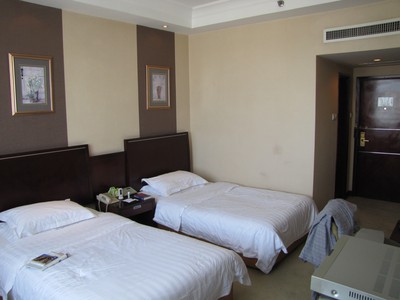
Read my review on chinatravel.net.


Read my review on chinatravel.net.
Railroad adventure V: Datong - Beijing Bei via Badaling
Going back from Datong to Beijing Bei (North), the train took a different route than on the outward trip. This route is very exciting since it goes very close to the Great Wall, and also features steep gradients (over 3 percent) and a switch-back).
We'll start at the Datong railway station, a monumental building. The letters on top say Da Tong zhan (station).
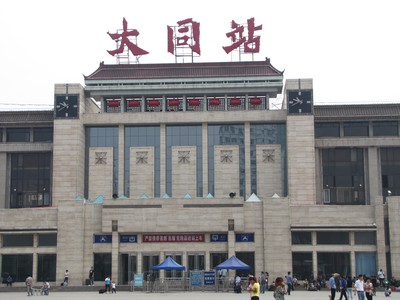
At first I thought that there was a huge line to get into the station, and I was happy to discover, though, that the lines were not to get into the station. Chinese railway tickets are sold a certain number of days in advance, and clearly these people were waiting to buy tickets to desirable destinations. I believe the large electronic board announces how many tickets are left for various destinations and in various classes. The Chinese railway system is underdimensioned for the demand, but China is building a lot of new railroads (again throwing light on my earlier comments about the endowed chair in railroad engineering which Yale has made into a general civil engineering chair).

The first part of the trip was uneventful. I covered this distance before, and the windows were even dirtier this time, making it hard to get good pictures. I did see a few interesting things that I did not see on the outward journey, such as this town with a city wall. I do not know its name, but I shall try to find out.
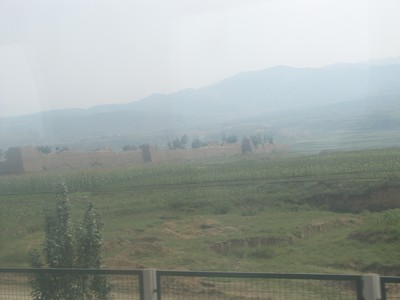
Chinese sheep.
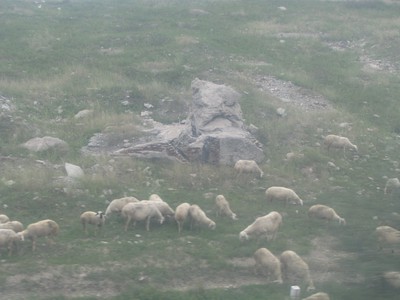
Wind power.

Each car has its own attendent, and I was fascinated and impressed by how conscientious the attendents were. The one in my car was very careful that all the luggage on the luggage racks was correctly placed, with no straps hanging down. He often had to climb a seat to reach, but he always used a piece of textile to climb on. (I would be good as a car attendent, for I am able to reach the overhead spaces without climbing the seats!). When he was not doing anything in particular, he still sat and watched over the car from his own little compartment at the end.
A funny detail was when the tickets where checked. Then the attendant came first and shouted "Tickets up" (I think I recognized these words). Then three conductors came and quickly punched everyone's ticket. No "thank yous" or other small talk, just a very efficient operation.
Note, this is a hard seat car (second class). Still airconditioned, and very clean. In fact the attendant was constantly cleaning the floors. I had to lift my feet five times in seven hours to allow him to sweep or mop the floor!

When we had a longer stop, the attendant in the soft seat-car (first class) even polished the sign indicating the origin and destination of the train.

That sign, after being polished. The train ran from Huhehaote (Hohhot) in Inner Mongolia to Tongliao (also in Inner Mongolia). This is a trip of 1478 kilometers that it makes in 25 hours and 15 minutes.
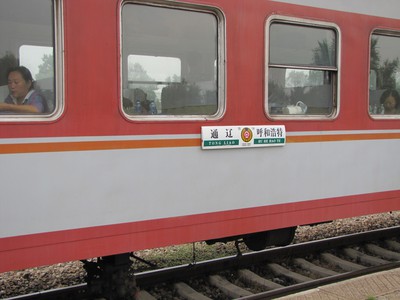
By the way, the train was five minutes late from Datong, but we still arrived two minutes early in Beijing.
Soon after Xuanhua, where we changed engines from an electric to a diesel, the tracks we followed diverged from those that I had followed on the outward journey. There was now single track, with wooden sleepers, and no longer any electric overhead wire and no continuously welded tracks (clickety-clack!). We were getting in on the old line from Beijing to the northwest, to so-called Jingzhang railway. It was built between 1905 and 1909 (when China was still ruled by the imperial dynasty of Qing).
The train stopped for over 20 minutes in Kangzhuang in order to attach a help engine to the end of the train. We were going to be going downhill at steep gradients down to the plain around Beijing, and the train must have needed the extra breaking power.
The train ride between Kanzhuang and Nankou (where the help engine was removed) is spectacular. Not only is the natural scenery magnificent. The track goes in a narrow gorge with high and steep mountains on both sides, but it also gets very close to the Great Wall of China. This is the most famous section of the wall, the one closest to Beijing, and thus the one most visited by tourists. I got many pictures of the wall. Sadly, the dirty windows and the ever denser fog conspired to make the image quality rather poor. Here are, at any rate, some of the best.

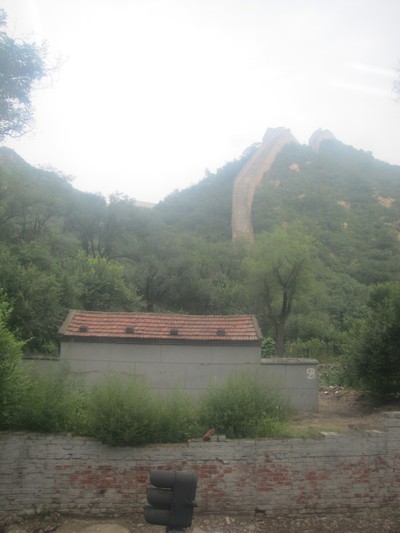
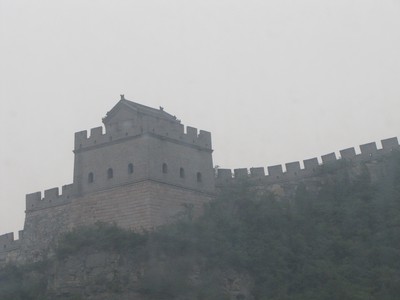
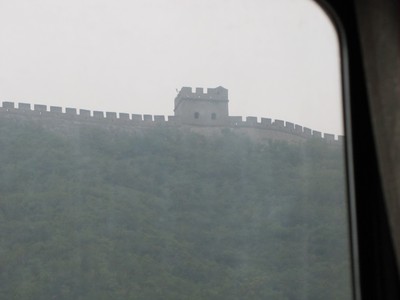
Just after Badaling station (where we did not stop), the train passed through a tunnel, which must have been about 2 kilometers long. Just after the tunnel we arrived at Qinglongqiao station where there is a switchback. The train stops on the station, then changes direction to go down a different track after the switch have been changed. In this way a very steep gradient can be avoided. The railway does still have a very steep gradient, up to 33 pro mille (greater than on the Gotthardbahn, see Adventure II). So we stopped, and reversed. Then the train went very slowly and carefully downhill.
In the picture one sees the lower of the two rails, photographed from the train which is still on the upper rail.

The Jingzhang railway is the first railway in China to be financed, engineered and built by native Chinese. The engineer in charge was 詹天佑, Jeme Tien Yow (1861-1919; with modern pinyin transliteration his name would be Zhan Tianyou). Jeme graduate from Yale College in 1881 with a degree in civil engineering with specialization in railway engineering! (I hope you can see why I still wonder why Yale got rid of our endowed chair in railway engineering!). He was buried at the switchback, where his statue also stands (on his grave?).

A photograph of him, borrowed from Wikipedia.
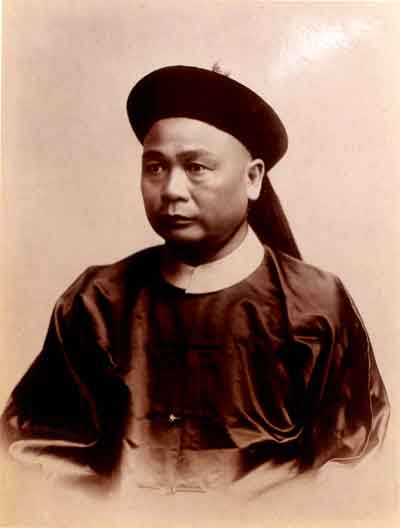
There were several switchbacks in Sweden. One of them was on the narrow-gauge Hörken-Fredriksberg-Neva railroad, and the switch was at Lövsjön, which is about 50 kilometers from Ludvika, today in the middle of nowhere. I visited the site together with my father and my children last month! Alas, I did not have my camera with me then, but I found a recent photo on a webpage.
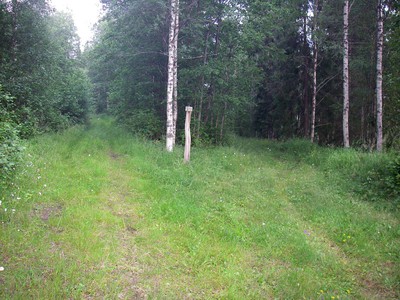
We'll start at the Datong railway station, a monumental building. The letters on top say Da Tong zhan (station).

At first I thought that there was a huge line to get into the station, and I was happy to discover, though, that the lines were not to get into the station. Chinese railway tickets are sold a certain number of days in advance, and clearly these people were waiting to buy tickets to desirable destinations. I believe the large electronic board announces how many tickets are left for various destinations and in various classes. The Chinese railway system is underdimensioned for the demand, but China is building a lot of new railroads (again throwing light on my earlier comments about the endowed chair in railroad engineering which Yale has made into a general civil engineering chair).

The first part of the trip was uneventful. I covered this distance before, and the windows were even dirtier this time, making it hard to get good pictures. I did see a few interesting things that I did not see on the outward journey, such as this town with a city wall. I do not know its name, but I shall try to find out.

Chinese sheep.

Wind power.

Each car has its own attendent, and I was fascinated and impressed by how conscientious the attendents were. The one in my car was very careful that all the luggage on the luggage racks was correctly placed, with no straps hanging down. He often had to climb a seat to reach, but he always used a piece of textile to climb on. (I would be good as a car attendent, for I am able to reach the overhead spaces without climbing the seats!). When he was not doing anything in particular, he still sat and watched over the car from his own little compartment at the end.
A funny detail was when the tickets where checked. Then the attendant came first and shouted "Tickets up" (I think I recognized these words). Then three conductors came and quickly punched everyone's ticket. No "thank yous" or other small talk, just a very efficient operation.
Note, this is a hard seat car (second class). Still airconditioned, and very clean. In fact the attendant was constantly cleaning the floors. I had to lift my feet five times in seven hours to allow him to sweep or mop the floor!

When we had a longer stop, the attendant in the soft seat-car (first class) even polished the sign indicating the origin and destination of the train.

That sign, after being polished. The train ran from Huhehaote (Hohhot) in Inner Mongolia to Tongliao (also in Inner Mongolia). This is a trip of 1478 kilometers that it makes in 25 hours and 15 minutes.

By the way, the train was five minutes late from Datong, but we still arrived two minutes early in Beijing.
Soon after Xuanhua, where we changed engines from an electric to a diesel, the tracks we followed diverged from those that I had followed on the outward journey. There was now single track, with wooden sleepers, and no longer any electric overhead wire and no continuously welded tracks (clickety-clack!). We were getting in on the old line from Beijing to the northwest, to so-called Jingzhang railway. It was built between 1905 and 1909 (when China was still ruled by the imperial dynasty of Qing).
The train stopped for over 20 minutes in Kangzhuang in order to attach a help engine to the end of the train. We were going to be going downhill at steep gradients down to the plain around Beijing, and the train must have needed the extra breaking power.
The train ride between Kanzhuang and Nankou (where the help engine was removed) is spectacular. Not only is the natural scenery magnificent. The track goes in a narrow gorge with high and steep mountains on both sides, but it also gets very close to the Great Wall of China. This is the most famous section of the wall, the one closest to Beijing, and thus the one most visited by tourists. I got many pictures of the wall. Sadly, the dirty windows and the ever denser fog conspired to make the image quality rather poor. Here are, at any rate, some of the best.




Just after Badaling station (where we did not stop), the train passed through a tunnel, which must have been about 2 kilometers long. Just after the tunnel we arrived at Qinglongqiao station where there is a switchback. The train stops on the station, then changes direction to go down a different track after the switch have been changed. In this way a very steep gradient can be avoided. The railway does still have a very steep gradient, up to 33 pro mille (greater than on the Gotthardbahn, see Adventure II). So we stopped, and reversed. Then the train went very slowly and carefully downhill.
In the picture one sees the lower of the two rails, photographed from the train which is still on the upper rail.

The Jingzhang railway is the first railway in China to be financed, engineered and built by native Chinese. The engineer in charge was 詹天佑, Jeme Tien Yow (1861-1919; with modern pinyin transliteration his name would be Zhan Tianyou). Jeme graduate from Yale College in 1881 with a degree in civil engineering with specialization in railway engineering! (I hope you can see why I still wonder why Yale got rid of our endowed chair in railway engineering!). He was buried at the switchback, where his statue also stands (on his grave?).

A photograph of him, borrowed from Wikipedia.

There were several switchbacks in Sweden. One of them was on the narrow-gauge Hörken-Fredriksberg-Neva railroad, and the switch was at Lövsjön, which is about 50 kilometers from Ludvika, today in the middle of nowhere. I visited the site together with my father and my children last month! Alas, I did not have my camera with me then, but I found a recent photo on a webpage.

Not my train
The same day as I traveled by train from Datong to Beijing, a train accident happened in south-western China. China Daily claims that there were no injuries, which is hard to believe. In the text of their article it says that "no casualties have been reported," which sounds closer to the truth.
Many rivers in that part of China are overflowing, because it has rained heavily. I suppose the bridge must have been undermined.
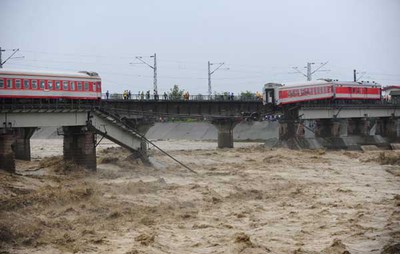
There is a reportage about this by the BBC. It explains that the cars remained dangling from the bridge for a while before they fell, which explains why there could have been no injuries (or no serious injuries, as the BBC puts it).
Many rivers in that part of China are overflowing, because it has rained heavily. I suppose the bridge must have been undermined.

There is a reportage about this by the BBC. It explains that the cars remained dangling from the bridge for a while before they fell, which explains why there could have been no injuries (or no serious injuries, as the BBC puts it).
My cat
As I was waiting for my driver to come back to the car at the Hanging Monastery, I was approached by a vendor, who really wanted to sell me something. He showed me this cat first of all. He wanted 130 yuan for it, which is really too much. In any case, he would not go away, and I liked the cat, so I started to haggle with him, especially since the driver was slow in showing up, so there was not much escape. In the end, I got it for 50, which is probably too high a price, but still. I like it. It is a small tea pot made of brass. It was only when the driver arrived and I walked towards the door of the car that the seller agreed to my last bid. While we were haggling, he tried to sell me a lot of other things.
So I guess the cat is my birthday present to myself.
The seller apparently found my repeated "wo buyao" (I do not want) to be amusing, for he repeated it laughingly several times. I suppose there was something funny about my pronounciation (I think I make the b too soft).
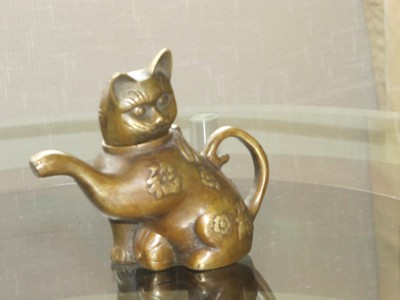
So I guess the cat is my birthday present to myself.
The seller apparently found my repeated "wo buyao" (I do not want) to be amusing, for he repeated it laughingly several times. I suppose there was something funny about my pronounciation (I think I make the b too soft).

Understatement of the month
Ningping made the understatement of the month the morning when we were leaving our apartments to go to the railway station for my trip to Datong. I asked her whether I should really take my hat, or if it would make me stand out too much.
"Anders, take the hat. You'll stand out anyway," was her response. As I have written below, the local people here certainly notice me.
"Anders, take the hat. You'll stand out anyway," was her response. As I have written below, the local people here certainly notice me.
Mao joins my collection of miniature busts
I bought this at an indoors antiques market. Any number of busts of Mao with different expressions and in different sizes were for sale. And then of course I got his most famous book.
The bust will now join Carl X Gustaf, Socrates, Brahms, and other heroes of history on the top of my red book case.
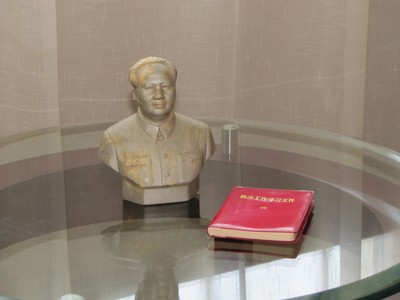
The bust will now join Carl X Gustaf, Socrates, Brahms, and other heroes of history on the top of my red book case.

Birthday trip to Xuan Kong Si
The famous Hanging (or Suspended) monastery close to Mount Hengshan was built by Taoist monks, starting in the sixth century on a rockface, 30 meters above the bottom of the valley. Yes, I walked through all of it, and yes, I was terrified (very low barriers especially for someone of my height, obviously old wood, very far to fall).
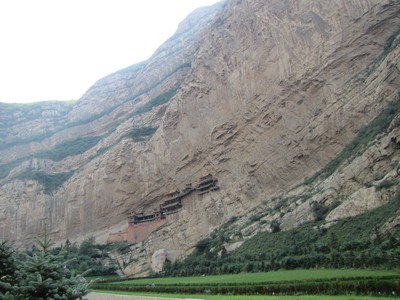
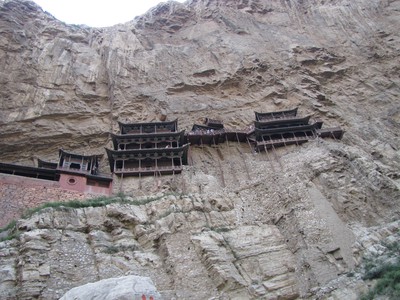
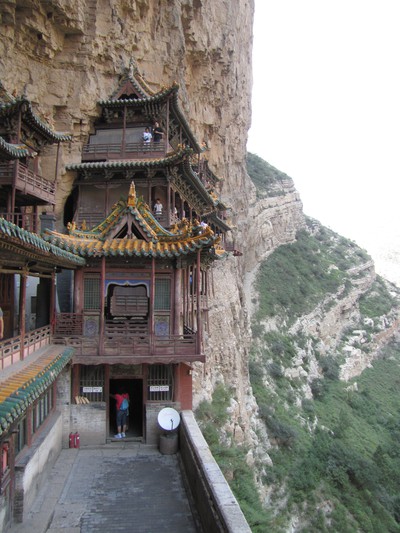

It is very hard to convey in photographs the utter sence of constantly balancing on the edge of a precipice, but perhaps this picture might go some way towards illustrating this. I am not very much given to acrophobia (höjdskräck), but this was a nerve-wracking experience. All the stairways and balconies, etc., were clearly designed for people much smaller than I. The valley in which the monastery is situated is very beautiful: steep walls on most sides, which contributed to the feeling of being a very small creature in a very large context.
The drop below is about 30 meters.

Apparently, these plugs into the mountain is what holds the monastery up on the side of the mountain, together with the long "stilts" under the buildings.


My driver and the car. He drove very well, calmly but fast. The car was clean when we started. This is a picture from when we got back to the hotel.
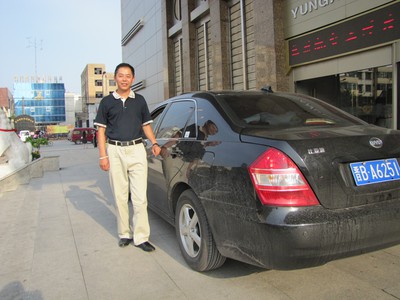




It is very hard to convey in photographs the utter sence of constantly balancing on the edge of a precipice, but perhaps this picture might go some way towards illustrating this. I am not very much given to acrophobia (höjdskräck), but this was a nerve-wracking experience. All the stairways and balconies, etc., were clearly designed for people much smaller than I. The valley in which the monastery is situated is very beautiful: steep walls on most sides, which contributed to the feeling of being a very small creature in a very large context.
The drop below is about 30 meters.

Apparently, these plugs into the mountain is what holds the monastery up on the side of the mountain, together with the long "stilts" under the buildings.


My driver and the car. He drove very well, calmly but fast. The car was clean when we started. This is a picture from when we got back to the hotel.

Birthday trip to Yunguan Shiku (caves)

To celebrate my birthday, I rented a car with a driver who took me to two monasteries (a very close friend apparently found it somewhat amusing that I would celebrate my birthday in monasteries, I am not sure why).
In the morning the Yunguan caves, a short distance from Datong, actually very close to the coal mine. They are a series of 53 man-made grottoes on the southern slopes of the Wuzhou Mountains which stretch over about 1 kilometer. They are enormously rich in Buddhist sculpture, 51,000 in fact, which - according to Baedeker - "betray Indian and Ancient Greek influences."
The largest sculpture is 17 meters tall, while the smallest is only two centimeters.
It all reminded me very much of the Ajanta caves in India, which I visited with my father in 1982. (Perhaps my father might want to scan a couple of pictures from that visit, so I can put them up here). But I think Yungang is richer in sculptures.
According to Weishu, or "The Northern Wei History" (an old history work), the Buddhist monk Tan Yao from Liangzhou persuaded the Northern Wei emperor Wen Cheng Di to begin to build this temple. "Five caves were excavated in the stone wall hewn out of the mountain ridge ... with one Buddha statue carved in each cave.... The carvings were of exceptional excellence and unparalleled throughout the world." The work began in 460.
I bought a beautiful coffetable book (all in Chinese) with pictures much more gorgeous than mine. Its historical introduction by Li Zhigou was translated by Zhang Jie and published in a separate booklet. This translation is excellent (unlike some that I give examples of below).
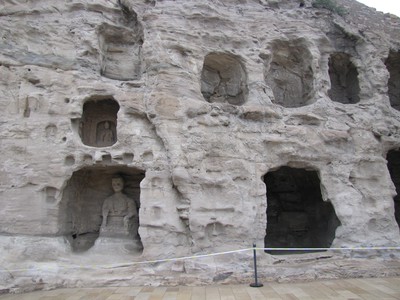




I believe this is Maitreya, whose right arm is supported by a four-armed warrior.
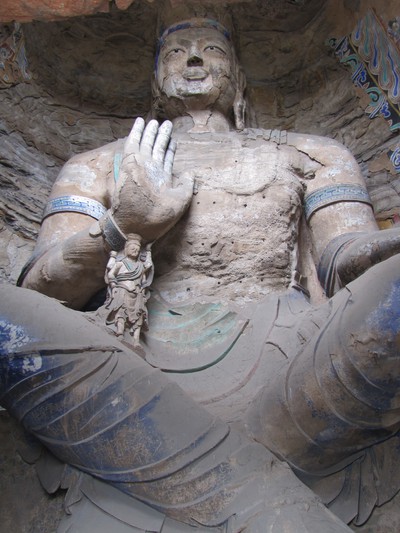
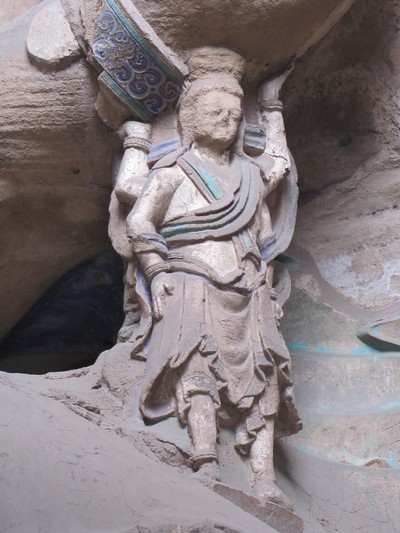

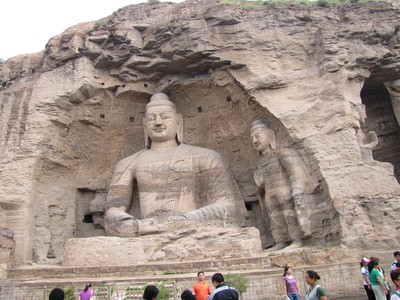


The caves have a website in English!
Language confusion
In general, I think it is very poor sport to make fun of people's short-comings in foreign languages, especially since people who know no or few foreign languages seem to think it is especially fun. I am sure the Chinese find my bold attempts to use their beautiful language as amusing as I find some of what I have seen and heard here in English. So here are some examples, noted by someone who once ordered a sun-flower in a French restaurant, when I wanted a nice, juicy piece of tenderloin ("tournesol" instead of "tournedos"!).
The Guest handbook in my hotel is a treasure trove of sentences worthy of The Private Eye, for example, among the regulations for guests:
3. Please not to smoke on the bed and in the elevators, and the dog-ends are only allowed to put in the ashtrays.
9. Please not walk out the room in barefoot.
12. Any person who involved irregularity like Prostitution, freak-out, smuggle and gambling will be punished according to relative Chinese law.
Poor dogs!
On the inside of the door:
Please don't worry if a fire is occurring We hotel have owned succor scattering facilities to sure you transmitted safely.
Today, I managed to tear open one of those free tea bag that one gets in hotel rooms (some rather good green tea here), since it was wrapped in one of those burglary-proof outer bags. Since they apparently forgot to clean my room today (about which I did not complain, since I really have not made much of a mess), I needed new tea bags. So I pressed the "Housekeeping" button on the phone. I first reached a very nice young lady, who did not speak English. She handed me over to a nice and very apologetic young man, to whom I explained in my best school English ("I seem to have torn a tea bag..."; well not really), than in simplified English, then I tried Chinese (chabao means tea bag), and finally he asked me to spell out each letter. A moment later a housemaid showed up with ... a shopping bag. It was a very nice one, and I am sorry I was not able to put my hands on it. Instead I showed her the torn tea bag, and she immediately came back with half a dozen. When I thanked her, she said something that I interpret as that she was honored to be thanked.
The hotel staff is very sweet and is struggling mightily with English. I have not really met anyone at the hotel with whom I could speak English in a normal way and expect to be understood. I think they are grateful that I am at least bothering to likewise struggle with Chinese.
The Guest handbook in my hotel is a treasure trove of sentences worthy of The Private Eye, for example, among the regulations for guests:
3. Please not to smoke on the bed and in the elevators, and the dog-ends are only allowed to put in the ashtrays.
9. Please not walk out the room in barefoot.
12. Any person who involved irregularity like Prostitution, freak-out, smuggle and gambling will be punished according to relative Chinese law.
Poor dogs!
On the inside of the door:
Please don't worry if a fire is occurring We hotel have owned succor scattering facilities to sure you transmitted safely.
Today, I managed to tear open one of those free tea bag that one gets in hotel rooms (some rather good green tea here), since it was wrapped in one of those burglary-proof outer bags. Since they apparently forgot to clean my room today (about which I did not complain, since I really have not made much of a mess), I needed new tea bags. So I pressed the "Housekeeping" button on the phone. I first reached a very nice young lady, who did not speak English. She handed me over to a nice and very apologetic young man, to whom I explained in my best school English ("I seem to have torn a tea bag..."; well not really), than in simplified English, then I tried Chinese (chabao means tea bag), and finally he asked me to spell out each letter. A moment later a housemaid showed up with ... a shopping bag. It was a very nice one, and I am sorry I was not able to put my hands on it. Instead I showed her the torn tea bag, and she immediately came back with half a dozen. When I thanked her, she said something that I interpret as that she was honored to be thanked.
The hotel staff is very sweet and is struggling mightily with English. I have not really met anyone at the hotel with whom I could speak English in a normal way and expect to be understood. I think they are grateful that I am at least bothering to likewise struggle with Chinese.
Wall of the Nine Dragons
"Feng shui" means "air, water", but the combination also represents the ancient Chinese principles of organizing a house (dwelling or otherwise) in the right way. One basic principle is that the main entrance should face south (as, I am happy to report, does the entrance of my house in New Haven). This avoids some of the risk of the evil spirits that come from the north (wait a minute, where did they get that idea?). But it is not sufficient that the entrance faces south, it should also have a wall in front of it (note to self: build wall outside entrance at home in New Haven). The Wall of the Nine Dragons in Datong is the oldest such wall preserved in China.
It was built in 1392 to protect the residence of Zhu Gui, who was the thirteenth son of Zhu Yanzhang, the first emperor of the Ming dynasty. The residence itself burned down in 1644, but the wall was saved. It is huge. And the dragons are very beautiful. I have several "portrait pictures" of some of them, but the internet connection is so slow here at the hotel that those will have to wait until I am back in Beijing. So please check back, if you are interested.

According to my Baedeker (2000) the dragons are "beneficient beings, numbering nine for luck, that are dancing in the clouds, grabbing for dragon pearls."
The dragons certainly look benevolent, even cute.


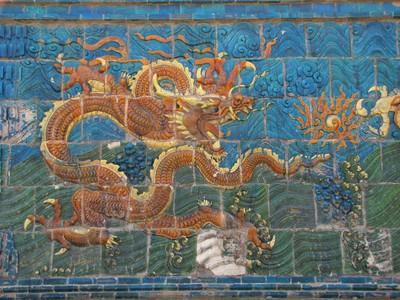
Talking of Baedeker. Anyone who knows me more closely knows that I love Baedeker's travel guides, preferably from before 1914. They are still good. Even this modern one has much attention to detail, more information than flash, and good maps - all features that one is used to from the pre-war editions. And I have to use a modern one since Baedeker treated China very poorly before 1914, with only a few pages about Beijing and the Chinese places on the Manchurian branch of the Transiberian (including, however, Port Arthur) in the 1912 edition. But what has happened to Baedeker's proud tradition of flawless translations into French and English? The 2000 edition is riddled with translation errors.
It was built in 1392 to protect the residence of Zhu Gui, who was the thirteenth son of Zhu Yanzhang, the first emperor of the Ming dynasty. The residence itself burned down in 1644, but the wall was saved. It is huge. And the dragons are very beautiful. I have several "portrait pictures" of some of them, but the internet connection is so slow here at the hotel that those will have to wait until I am back in Beijing. So please check back, if you are interested.

According to my Baedeker (2000) the dragons are "beneficient beings, numbering nine for luck, that are dancing in the clouds, grabbing for dragon pearls."
The dragons certainly look benevolent, even cute.



Talking of Baedeker. Anyone who knows me more closely knows that I love Baedeker's travel guides, preferably from before 1914. They are still good. Even this modern one has much attention to detail, more information than flash, and good maps - all features that one is used to from the pre-war editions. And I have to use a modern one since Baedeker treated China very poorly before 1914, with only a few pages about Beijing and the Chinese places on the Manchurian branch of the Transiberian (including, however, Port Arthur) in the 1912 edition. But what has happened to Baedeker's proud tradition of flawless translations into French and English? The 2000 edition is riddled with translation errors.
大同 Datong
So I am spending three days in Datong, in Shanxi province, six hours by train from Beijing. Many have asked why I wanted to see Datong, both Westerners and Chinese. I even spoke with a representative of the local Turist bureau said that they recommend two days for seeing Datong, and that three days seemed exaggerated (well, that was not the word he used, but what he meant). He was otherwise very helpful
Datong is not just yet another provincial backwater, it was once the capital of China, or at least the Northern half thereof. After the Wei dynasty had unified northern China in 439 they put their capital in Pingcheng, as Datong then was called. This was the high point of Datong, when for example the Yungang caves were constructed (I have visited them and will report).
The city continued to flourish also after the capital was moved in 494 to Luoyang. It contained many Buddhist monasteries, temples, and such, some of which survives. What also survives are remnants of the city wall. So why wonder why I wanted to go to Datong. I am grateful to Xiaojie, who suggested this trip when it turned out to be impossible to get a train ticket for anywhere south of the Huang He (probably too hot there anyway for my northern physiognomy; Datong is at 1216 meters above sea level - that is 3990 ft for those of you who have not yet accepted the Enlightenment - and is pleasantly cooler than Beijing.
Datong is in the middle of a coal field, and there is a huge coal mine not far from the Yungang caves. As places that have access to cheap coal usually are, Datong was a center for steam locomotives. In fact, such engines were manufactured here until 1989, most likely the last factory in the world to produce steam locomotives. According to the guide book I have to the Transsibirian Railroad (the Beijing branch of which goes through Datong), the factory still makes parts for steam engines, but they also say that it is possible to get to go on a guided tour of the factory, if one contacts the Tourist Bureau. That was why I asked the reception to call them. Alas, it is no longer possible, and the train engine museum is closed, or so I was told.
So I will have to do with the medieval stuff!
It is very fun to be here in many ways, but I have particularly noticed that the inhabitants are not used to western tourists. There is an Italian family staying here in the hotel (Datong Yungang International Hotel; recommended!), but they seem very keen to avoid eye contact with me. Otherwise, I have seen very few westerners, and clearly the inhabitants have not seen more. When I am walking on the sidewalks, people look at me. The young ones often giggle, and some (especially the ones in school age) say "hello," to which I always respond "hello, ni hao".
When I walked from the train station to the hotel (a little longer than I had imagined; I have not yet learnt that Chinese blocks are longer than in Ludvika), I was stopped by this charming trio.

They were in training to staff a hotel that soon will be opened. I think the one in black is a manager, and I suppose it was good training for them to talk with me. We chatted for a while, both in English and Chinese, and they allowed me to photograph them. Otherwise, I have had very little experience of what my new Baedeker from 2000 say: that the Chinese do not like to be photographed. Some have even asked me to photograph them, like these two strapping young men, Messrs. Ma Hui Chao and Jing Wen Hui, with whom I spoke quite a lot. They are students in "Zhong xue", which they translated "Middle school", although I wonder if that would not be what in the USA is called high school (gymnasieskola i Sverige).

You can also see that at least Hui Chao was not afraid of something else that Baedeker says the Chinese abhor: bodily contact. He grabbed me as you can see. Soon there were more people who wanted to be in a picture. They insisted to give me their telephone numbers, and they got mine.
All in all, people here are amazingly friendly and willing to work to understand and to make themselves understood. I think it helps that I bothered to learn some phrases in Chinese. People, by the way, praise my pronounciation, which surely is largely politeness, but also a reflection of that I had a very good teacher in Joyce.
I occasionally feel the smell of burning coal, but not particularly often. There is at least one giant thermal power plant just outside town, with at least five enormous chimneys that spew out dense smoke. Those must be fired by coal. The town is also very dusty. My shoes are light brown when I come in, but I have noticed no accumulation of coal soot on collars and such, as one is supposed to get in coal towns. The air is supposed to be very polluted, but as in Beijing, I have had no immediate problems with that. Although I suppose that yellow tinge to these clouds might not be entirely healthy.

Well, this as an introduction to Datong. I will deal with specific issues in separate entries. Here follows some assorted photos from the city.
Feuerwehr? Well, the Datong fire brigade sports a German sobriquet.
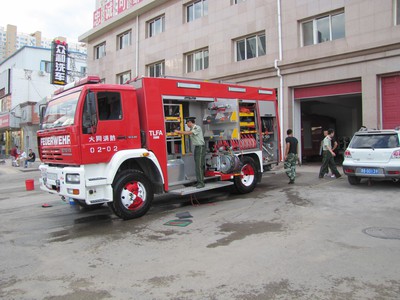
There are many street vendors in Datong, often selling off the back of a pickup truck.
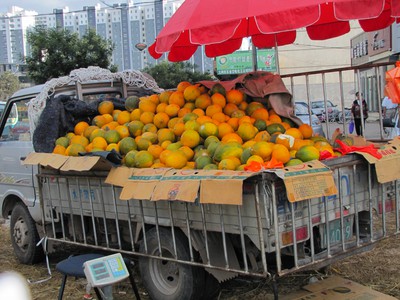
Garbage collection in Datong. I am sorry for these poor people.
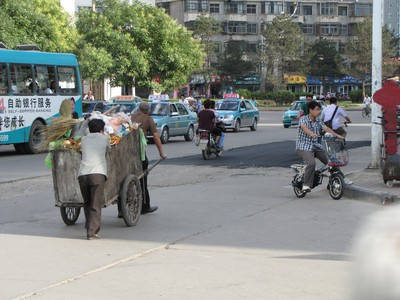
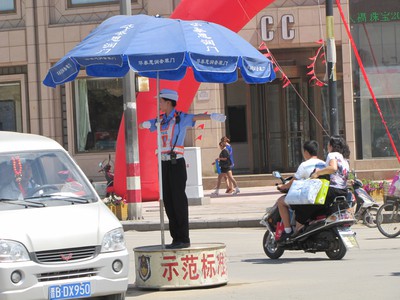
No, I have not tried this restaurant. And I will not.

Datong is not just yet another provincial backwater, it was once the capital of China, or at least the Northern half thereof. After the Wei dynasty had unified northern China in 439 they put their capital in Pingcheng, as Datong then was called. This was the high point of Datong, when for example the Yungang caves were constructed (I have visited them and will report).
The city continued to flourish also after the capital was moved in 494 to Luoyang. It contained many Buddhist monasteries, temples, and such, some of which survives. What also survives are remnants of the city wall. So why wonder why I wanted to go to Datong. I am grateful to Xiaojie, who suggested this trip when it turned out to be impossible to get a train ticket for anywhere south of the Huang He (probably too hot there anyway for my northern physiognomy; Datong is at 1216 meters above sea level - that is 3990 ft for those of you who have not yet accepted the Enlightenment - and is pleasantly cooler than Beijing.
Datong is in the middle of a coal field, and there is a huge coal mine not far from the Yungang caves. As places that have access to cheap coal usually are, Datong was a center for steam locomotives. In fact, such engines were manufactured here until 1989, most likely the last factory in the world to produce steam locomotives. According to the guide book I have to the Transsibirian Railroad (the Beijing branch of which goes through Datong), the factory still makes parts for steam engines, but they also say that it is possible to get to go on a guided tour of the factory, if one contacts the Tourist Bureau. That was why I asked the reception to call them. Alas, it is no longer possible, and the train engine museum is closed, or so I was told.
So I will have to do with the medieval stuff!
It is very fun to be here in many ways, but I have particularly noticed that the inhabitants are not used to western tourists. There is an Italian family staying here in the hotel (Datong Yungang International Hotel; recommended!), but they seem very keen to avoid eye contact with me. Otherwise, I have seen very few westerners, and clearly the inhabitants have not seen more. When I am walking on the sidewalks, people look at me. The young ones often giggle, and some (especially the ones in school age) say "hello," to which I always respond "hello, ni hao".
When I walked from the train station to the hotel (a little longer than I had imagined; I have not yet learnt that Chinese blocks are longer than in Ludvika), I was stopped by this charming trio.

They were in training to staff a hotel that soon will be opened. I think the one in black is a manager, and I suppose it was good training for them to talk with me. We chatted for a while, both in English and Chinese, and they allowed me to photograph them. Otherwise, I have had very little experience of what my new Baedeker from 2000 say: that the Chinese do not like to be photographed. Some have even asked me to photograph them, like these two strapping young men, Messrs. Ma Hui Chao and Jing Wen Hui, with whom I spoke quite a lot. They are students in "Zhong xue", which they translated "Middle school", although I wonder if that would not be what in the USA is called high school (gymnasieskola i Sverige).

You can also see that at least Hui Chao was not afraid of something else that Baedeker says the Chinese abhor: bodily contact. He grabbed me as you can see. Soon there were more people who wanted to be in a picture. They insisted to give me their telephone numbers, and they got mine.
All in all, people here are amazingly friendly and willing to work to understand and to make themselves understood. I think it helps that I bothered to learn some phrases in Chinese. People, by the way, praise my pronounciation, which surely is largely politeness, but also a reflection of that I had a very good teacher in Joyce.
I occasionally feel the smell of burning coal, but not particularly often. There is at least one giant thermal power plant just outside town, with at least five enormous chimneys that spew out dense smoke. Those must be fired by coal. The town is also very dusty. My shoes are light brown when I come in, but I have noticed no accumulation of coal soot on collars and such, as one is supposed to get in coal towns. The air is supposed to be very polluted, but as in Beijing, I have had no immediate problems with that. Although I suppose that yellow tinge to these clouds might not be entirely healthy.

Well, this as an introduction to Datong. I will deal with specific issues in separate entries. Here follows some assorted photos from the city.
Feuerwehr? Well, the Datong fire brigade sports a German sobriquet.

There are many street vendors in Datong, often selling off the back of a pickup truck.

Garbage collection in Datong. I am sorry for these poor people.


No, I have not tried this restaurant. And I will not.

Jag idag 17 augusti 2010
Två jag idag på födelsedagen: på morgonen och på eftermiddagen.
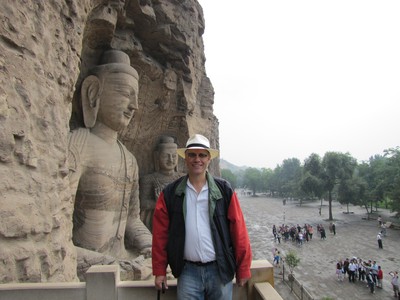
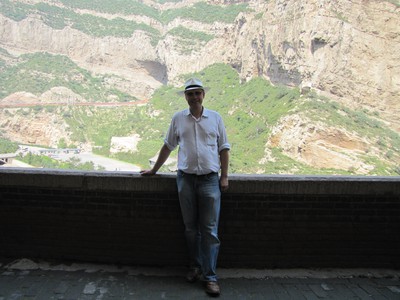


Jag idag 16 augusti 2010
Jag har massor av bilder från de senaste två dagarna i Datong med omnejd, men jag får väl börja med två Jag idag-bilder. :)
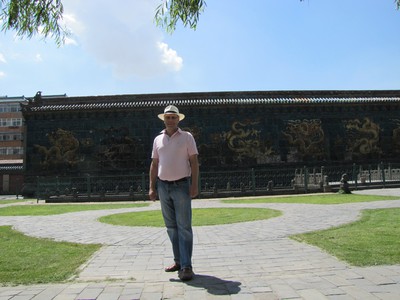
Den här är tagen framför Muren med nio drakar.

Den här är tagen framför Muren med nio drakar.
Railroad adventure IV: Beijing Xi - Datong
Datong is an old city in Shanxi province with a lot of remnants from what in the West would be the Middle Ages, including a preserved city wall, Buddhist monasteries, the oldest remaining dragon wall in china, and more. So I got a train from Beijing Xi (West) train station to Datong. The trip took a little more than six hours, and there was some amazing scenery outside the windows, including views of the Great Wall.
I started out from Beijing Xi. The always wonderful Ningping accompanied me there in a taxi and guided me so that I would get to the right place.

I thought the station in Basel was big and crowded. This one was enormous in comparison. I took the photo at a moment when it was not so crowded.

The picture above is from the main concourse. On the sides of it were (12, I think) different waiting rooms. A big sign directed travellers to a specific waiting room depending on which train one wanted. Then there was a special waiting room for "mothers with children" (!) and disabled people. Since I am greatly disabled in my knowledge of Chinese, I was allowed to wait there (people in that room get to board the train first).
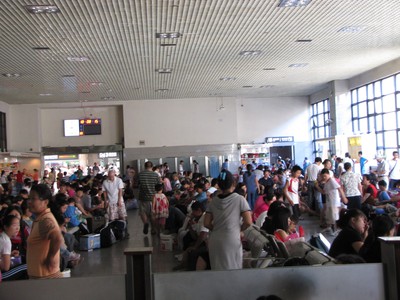
When we first arrived, my train's number was displayed in red, which means that it was delayed. It did not say for how long, and a special sign said (in Chinese; Ningping interpreted) that they were trying to find out how late is was going to be. When I realized that the train had started out from Nancheng in Southern China at 11 a.m. the day before (and was supposed to leave from Beijing at 9.36, I despaired and expected it to be many hours late. Just as I was considering whether I would be able to change my ticket for a later train that might leave earlier did a time pop up for my train.
As you all can see, the sign tells us that the 1483 to Baotou (which is in Inner Mongolia) would leave at 10.12.

The train arrived, and I got onboard to the space that was mine, with kind help from the railway personell. The train (no. 1482/1483) runs Nanchang-Baotou, which is a distance of 2398 kilometers, and which according to the time table takes 35 hours and 4 minutes. I was only on it for a little more than 6 hours.


The train was enormous and absolutely packed. I never saw the end of it. I was in car 12, I walked to car 15-16 before turning around, not even then being sure where the end was. It must have had more than twenty cars. It started and ran very smoothely (Chinese railroads maintains their tracks, even out in the boondogs, considerably better than do American railway companies). Only when the train broke was there ever a jilt. I guess the train does not have the most modern braking pads. The fact that the train number does not have letter in front of it, means that it is an old, "traditional" train that stops often.

Most of the train are cars with couchettes (Sw. "liggvagn"), and I had one of those. The berths were comfortable, and - miraculously - not shorten than I. I even took a nap. But most of the time, I was at the window taking in the view and snapping photos.
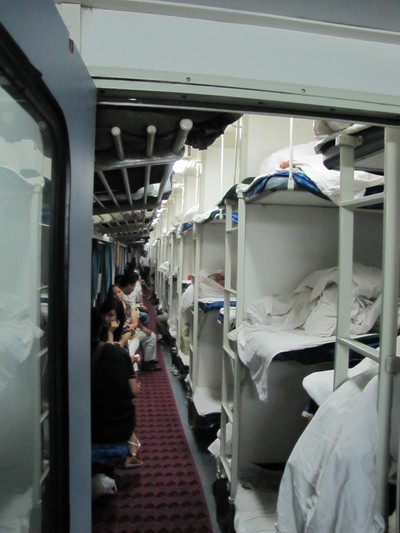
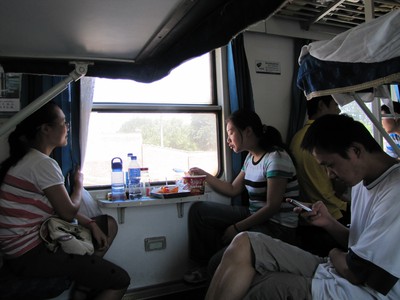
So some view from the windows, dirtier than the Swiss windows, but I have a better camera now, so the pictures came through. Soon after leaving Beijing Xi did we meet a freight train, which was turning off to another route. It was very long, probably some 40 cars, and I think it was headed by two engines (much like the trains of iron ore from Blötberget to Domnarvet in my childhood, for which we often waited forever at the crossing on the way from Ludvika to our home outside town). China transports very much of its internal freight by train. A very good idea.

A clear sign of industrializing China: high-voltage tranfer lines, heavy work in a dry riverbed, and a provisional (?) bridge over it.

Our track was joined by a track coming from the side on a slender bridge. A single track only, but I guess that they are building a second bridgs on those pillars in the foreground.

We approached the mountain range that I think is called the Western Hills. Soon we were going up the mountains, which produced many astonishing sights. Some of the best were visible so briefly that I had no chance of photographing them. There were very many tunnels (can I guess 30-40), some of them very long, several kilometers.
The route we took is a short cut built, I think, in the 1950s to supplement the original route which I believe I shall take back to Beijing.
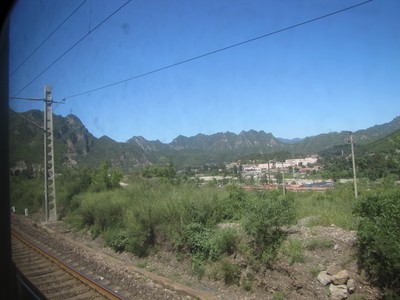
The train windows now produced wonder upon wonder.
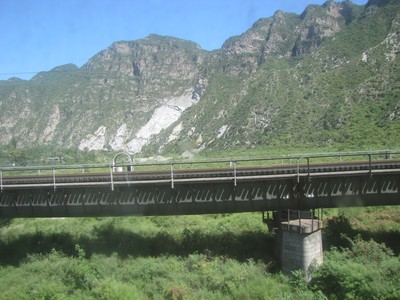

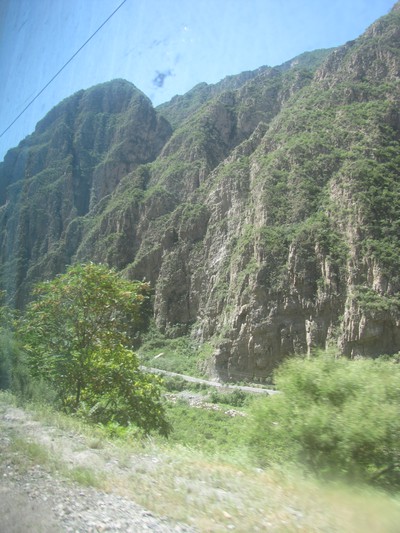
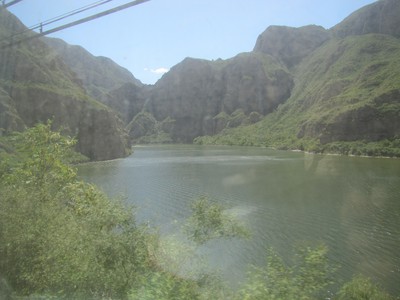

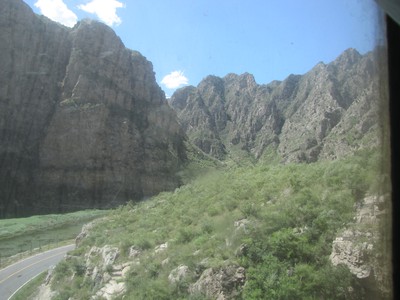



The track went parallel to the Great Wall. but at some distance, for several kilometers around Yanggao. Sometimes one could easily see it.
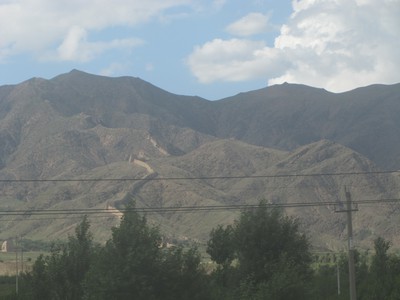
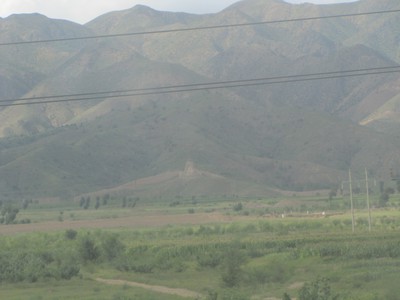
I made friends on the train. My closest neighbor in the bunks was this woman from Baotou, who also took the photo of me that follows.
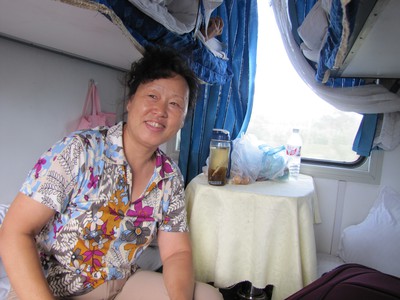
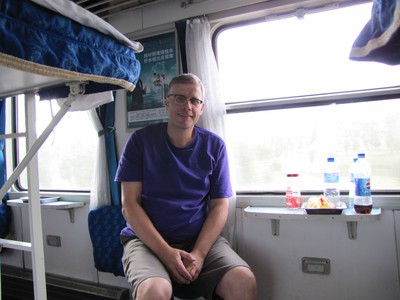
I "spoke" with several others, too, a young couple who were on the second tier in my compartment, a man from Inner Mongolia with wonderful Mongolian facial features (but he did not want to be photographed), and two school girls, who were the only ones who spoke some English. One of the girls was reading The Da Vinci Code in Chinese! She told me that she likes the book.
I am certain that I was the only European on the train, and people were obviously curious. I broke the ice by asking in Chinese the young man where the toilet is. When I came back, a man asked me from where I came. As I answered, there were happy Chinese faces poking out from all tiers of the bunks, following the conversation (such as it was; we had severe problems understanding each other). When I left, everyone said goodbye, zaijian!
OK, so I mentioned the toilet. I am sure you are all curious about what it was like. It was cleaner than some toilets I have seen on SJ trains (Swedish rail company).

But the style was standard squatting, Asian-style.

I started out from Beijing Xi. The always wonderful Ningping accompanied me there in a taxi and guided me so that I would get to the right place.

I thought the station in Basel was big and crowded. This one was enormous in comparison. I took the photo at a moment when it was not so crowded.

The picture above is from the main concourse. On the sides of it were (12, I think) different waiting rooms. A big sign directed travellers to a specific waiting room depending on which train one wanted. Then there was a special waiting room for "mothers with children" (!) and disabled people. Since I am greatly disabled in my knowledge of Chinese, I was allowed to wait there (people in that room get to board the train first).

When we first arrived, my train's number was displayed in red, which means that it was delayed. It did not say for how long, and a special sign said (in Chinese; Ningping interpreted) that they were trying to find out how late is was going to be. When I realized that the train had started out from Nancheng in Southern China at 11 a.m. the day before (and was supposed to leave from Beijing at 9.36, I despaired and expected it to be many hours late. Just as I was considering whether I would be able to change my ticket for a later train that might leave earlier did a time pop up for my train.
As you all can see, the sign tells us that the 1483 to Baotou (which is in Inner Mongolia) would leave at 10.12.

The train arrived, and I got onboard to the space that was mine, with kind help from the railway personell. The train (no. 1482/1483) runs Nanchang-Baotou, which is a distance of 2398 kilometers, and which according to the time table takes 35 hours and 4 minutes. I was only on it for a little more than 6 hours.


The train was enormous and absolutely packed. I never saw the end of it. I was in car 12, I walked to car 15-16 before turning around, not even then being sure where the end was. It must have had more than twenty cars. It started and ran very smoothely (Chinese railroads maintains their tracks, even out in the boondogs, considerably better than do American railway companies). Only when the train broke was there ever a jilt. I guess the train does not have the most modern braking pads. The fact that the train number does not have letter in front of it, means that it is an old, "traditional" train that stops often.

Most of the train are cars with couchettes (Sw. "liggvagn"), and I had one of those. The berths were comfortable, and - miraculously - not shorten than I. I even took a nap. But most of the time, I was at the window taking in the view and snapping photos.


So some view from the windows, dirtier than the Swiss windows, but I have a better camera now, so the pictures came through. Soon after leaving Beijing Xi did we meet a freight train, which was turning off to another route. It was very long, probably some 40 cars, and I think it was headed by two engines (much like the trains of iron ore from Blötberget to Domnarvet in my childhood, for which we often waited forever at the crossing on the way from Ludvika to our home outside town). China transports very much of its internal freight by train. A very good idea.

A clear sign of industrializing China: high-voltage tranfer lines, heavy work in a dry riverbed, and a provisional (?) bridge over it.

Our track was joined by a track coming from the side on a slender bridge. A single track only, but I guess that they are building a second bridgs on those pillars in the foreground.

We approached the mountain range that I think is called the Western Hills. Soon we were going up the mountains, which produced many astonishing sights. Some of the best were visible so briefly that I had no chance of photographing them. There were very many tunnels (can I guess 30-40), some of them very long, several kilometers.
The route we took is a short cut built, I think, in the 1950s to supplement the original route which I believe I shall take back to Beijing.

The train windows now produced wonder upon wonder.









The track went parallel to the Great Wall. but at some distance, for several kilometers around Yanggao. Sometimes one could easily see it.


I made friends on the train. My closest neighbor in the bunks was this woman from Baotou, who also took the photo of me that follows.


I "spoke" with several others, too, a young couple who were on the second tier in my compartment, a man from Inner Mongolia with wonderful Mongolian facial features (but he did not want to be photographed), and two school girls, who were the only ones who spoke some English. One of the girls was reading The Da Vinci Code in Chinese! She told me that she likes the book.
I am certain that I was the only European on the train, and people were obviously curious. I broke the ice by asking in Chinese the young man where the toilet is. When I came back, a man asked me from where I came. As I answered, there were happy Chinese faces poking out from all tiers of the bunks, following the conversation (such as it was; we had severe problems understanding each other). When I left, everyone said goodbye, zaijian!
OK, so I mentioned the toilet. I am sure you are all curious about what it was like. It was cleaner than some toilets I have seen on SJ trains (Swedish rail company).

But the style was standard squatting, Asian-style.

Day 3 in Beijing
I have mostly spent the day setting things up in my apartment and preparing for tomorrow's trip. I am going to take the train to Datong, which is an historically interesting town some distance to the north-west of Beijing. The train leaves at 9.26 and will take about six hours. There seem to be really interesting things in this town, so I am much looking forward to seeing it. I will return on Thursday.
I haven't been playing with my camera today; hence no pictures. But it was a good day. I feel that I am more settled in the apartment. I went out to shop a few things that I felt I need, such as indoor slippers, kitchen towels, and a few other odds and ends. In the evening, I had dinner with Ningping and Denise who works for the Stanford program. We talked about various places to which one might take the students. Apparently, there is some kind each Friday in our program. We all start off with a longer trip before classes start, but the destination has not yet been announced (although a little bird whispered in my ear, and it is a very exciting trip).
The hotel I am staying at (Datong Yungang International Hotel) is supposed to have free wireless. I bring my small computer, and if I can get it to work, I might make updates from the road.
I haven't been playing with my camera today; hence no pictures. But it was a good day. I feel that I am more settled in the apartment. I went out to shop a few things that I felt I need, such as indoor slippers, kitchen towels, and a few other odds and ends. In the evening, I had dinner with Ningping and Denise who works for the Stanford program. We talked about various places to which one might take the students. Apparently, there is some kind each Friday in our program. We all start off with a longer trip before classes start, but the destination has not yet been announced (although a little bird whispered in my ear, and it is a very exciting trip).
The hotel I am staying at (Datong Yungang International Hotel) is supposed to have free wireless. I bring my small computer, and if I can get it to work, I might make updates from the road.
Skype med barnen
Idag har jag pratat på Skype med mina söta barn. Elsa visade flera av sina dockor.
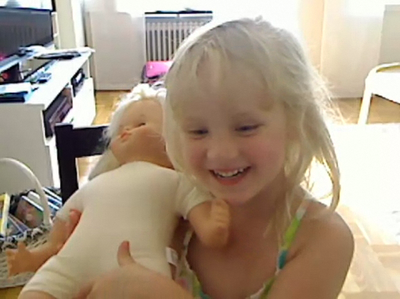
Hjalmar visade mig sitt Pokemonspel.
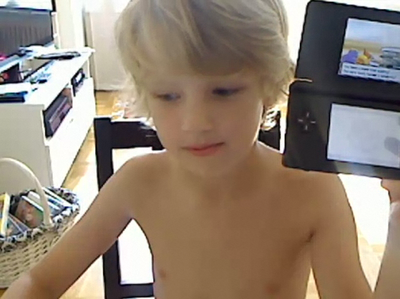


Hjalmar visade mig sitt Pokemonspel.


Noam Chomsky doctorate and lecture
Today's big event on campus was that the great linguist and political thinker Noam Chomsky was there to pick up an honorary doctorate and to give a public lecture. He seemed sprightly at 81. His lecture was entitled "Contours of World Order: Continuities and Change." He spoke intelligently from a carefully prepared manuscript, with a calm voice, even though some of what he said was controversial.
Afterwards, there was a question and answer-period led by a Chinese-born Harvard professor, who collected questions in writing from the audience. A large group of student voluntaries collected the questions from the audience and brought them up on stage. The first question contrasted the Chinese admiral Zheng He, who explored in the Indian Ocean in the early fifteenth century, with Christopher Columbus. While the latter followed colonial instincts that would lead to much violence, Zheng's expeditions were (by and large) peaceful and did not pursue colonialism.


More than 2000 people, mostly students, had come to listen.

It was a beautiful auditorium, but - alas - the seats were not constructed for anyone of a height that in Sweden is considered rather normal. I was definitely squeezed in, which in the end was very painful. Thus, I left when the question period began (although the questions I heard were unusually good for such circumstances).

Afterwards, there was a question and answer-period led by a Chinese-born Harvard professor, who collected questions in writing from the audience. A large group of student voluntaries collected the questions from the audience and brought them up on stage. The first question contrasted the Chinese admiral Zheng He, who explored in the Indian Ocean in the early fifteenth century, with Christopher Columbus. While the latter followed colonial instincts that would lead to much violence, Zheng's expeditions were (by and large) peaceful and did not pursue colonialism.


More than 2000 people, mostly students, had come to listen.

It was a beautiful auditorium, but - alas - the seats were not constructed for anyone of a height that in Sweden is considered rather normal. I was definitely squeezed in, which in the end was very painful. Thus, I left when the question period began (although the questions I heard were unusually good for such circumstances).

Jag idag fredag
For my traditional "Jag idag"-bild, I get to stand in front of the banderoll announcing that Noam Chomsky will get an honorary doctorate and will give a public lecture today.


Noodle dinner at Campus
Ningping and I had dinner on campus at a student restaurant that is actually called Campus. They only serve noodles. I ordered Chicken Curry noodle soup (and I ordered it myself, in Chinese, and was understood), which was very tasty indeed. It cost 5 RMB, for a large bowl, which was very large.
Outside the restaurant there were rows of bikes parked. The students bicycle a lot on campus, often at quite some speed, as they carefully maneuvre around pedestrians.
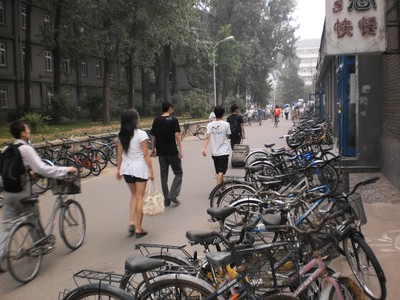
The restaurant.
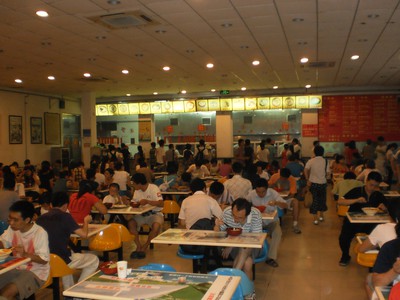
Me enjoying my noodles, which really were very good. They must have been freshly made; indeed, one could see people making noodles in the kitchen.

Outside the restaurant there were rows of bikes parked. The students bicycle a lot on campus, often at quite some speed, as they carefully maneuvre around pedestrians.

The restaurant.

Me enjoying my noodles, which really were very good. They must have been freshly made; indeed, one could see people making noodles in the kitchen.

My Chinese fountain pen
Yesterday, I bought a fountain pen at the Metro store. Today I used it for the first time. It works very well. The picture is from my office, and the pen rests on the edited manuscript of my book.
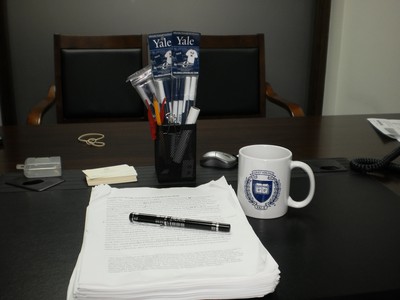

My second day in China
I did not sleep very well the first night in Beijing, so instead I slept rather much in the morning. I did not get to the office until about 2. Ningping was going with her husband to sign the lease for the apartment that will be inhabited by my colleagues Tina and Stuart when they arrive in a few days. So to get there we took the subway. Clean and pleasant, very convenient (there is a stop a few hundred meters from where I live). The glass wall separates us from the train until it has stopped and lined up its doors with those in the wall. Then the doors open.
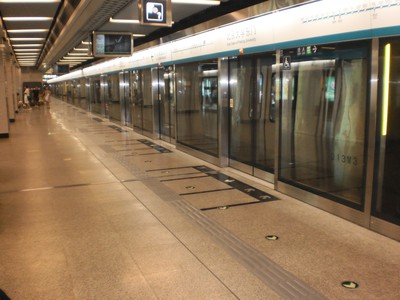
The inside look. The first train we took was not too crowded.

When we changed to line 10, there were more people who wanted to get on.

The apartment that my colleagues will get is very plesant, with a gorgeous view in all directions from the 17th floor. I noticed particularly the beautiful kitchen with a gas stove and also ... a revolving book case, the kind I always wanted. The landlord was able to tell me where he had bought it. While Ningping signed the paperwork, her husband Lejing and I walked to a shopping center. We spotted these two gentlemen on the way, and since I have had a request for photos of this kind of hat, I photographed them.
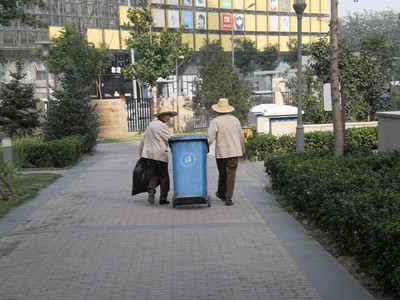
There was a tea store in the shopping center, where we were invited to taste tea. I bought some rather good tea.

In the basement of the shopping center, there was a large store of the German chain Metro. This was a wonderful place to walk around and look at what they had. I bought laundry detergent, wine, towels, pasta, a tin of crushed tomatoes, muesli, and various other odds and ends, including a fountain pen for 25 yuan (4 dollars!) and four bottles of blue ink for even less.
In the evening, Ningping and Lejing brought me to the Teachers dining hall at Beida. One went up to windows where food in various Chinese regions styles were offered (one style per window). Plus in one of the windows, one could pick out fresh vegetables which they then stir fried with the sauce of one's choice. Everything was amazingly fresh, and I had a good meal for very little expense (6.50 yuan, I think, plus 1.20 for a bottle of water).


The red banderoll reads: "The satisfaction of teachers and students is our highest priority." Why doesn't Yale have banderolls like that?
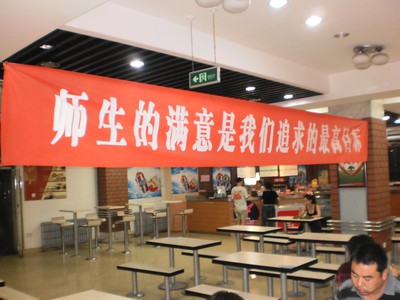
Ningping and Lejing.
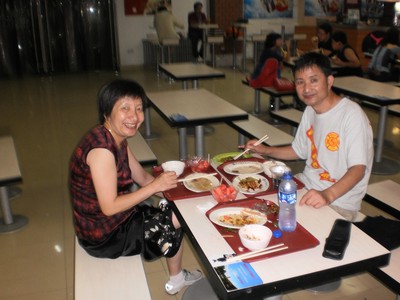
Here is a picture of only Lejing from the subway earlier in the day.

The kitchen were vegetables are stir-fried to order.
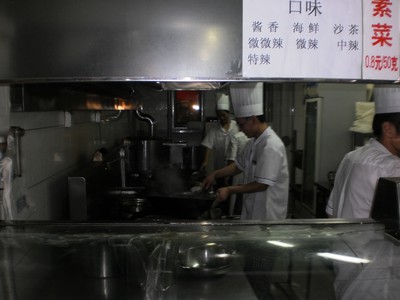
Finally, a picture from the West Gate of Peking University, which is its main entrance. The sign above the gate says "Beijing Daxue" and the calligraphy was made by none other than Mao Zedong. A lot of people where there photographing the sign.


The inside look. The first train we took was not too crowded.

When we changed to line 10, there were more people who wanted to get on.

The apartment that my colleagues will get is very plesant, with a gorgeous view in all directions from the 17th floor. I noticed particularly the beautiful kitchen with a gas stove and also ... a revolving book case, the kind I always wanted. The landlord was able to tell me where he had bought it. While Ningping signed the paperwork, her husband Lejing and I walked to a shopping center. We spotted these two gentlemen on the way, and since I have had a request for photos of this kind of hat, I photographed them.

There was a tea store in the shopping center, where we were invited to taste tea. I bought some rather good tea.

In the basement of the shopping center, there was a large store of the German chain Metro. This was a wonderful place to walk around and look at what they had. I bought laundry detergent, wine, towels, pasta, a tin of crushed tomatoes, muesli, and various other odds and ends, including a fountain pen for 25 yuan (4 dollars!) and four bottles of blue ink for even less.
In the evening, Ningping and Lejing brought me to the Teachers dining hall at Beida. One went up to windows where food in various Chinese regions styles were offered (one style per window). Plus in one of the windows, one could pick out fresh vegetables which they then stir fried with the sauce of one's choice. Everything was amazingly fresh, and I had a good meal for very little expense (6.50 yuan, I think, plus 1.20 for a bottle of water).


The red banderoll reads: "The satisfaction of teachers and students is our highest priority." Why doesn't Yale have banderolls like that?

Ningping and Lejing.

Here is a picture of only Lejing from the subway earlier in the day.

The kitchen were vegetables are stir-fried to order.

Finally, a picture from the West Gate of Peking University, which is its main entrance. The sign above the gate says "Beijing Daxue" and the calligraphy was made by none other than Mao Zedong. A lot of people where there photographing the sign.

At home in Zhongguanyuan, Beijing
It is notoriously difficult to photograph interiors, but here follows an attempt to picture my new home. Easy walking distance from Peking University (or Beida, as it is generally known here, abbreviated from Beijing Daxue).
But first an exterior photo of this living complex, which contains both hotel rooms, student rooms, and apartments.
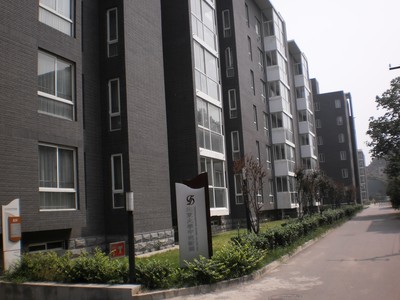
One gets directly into the living room from the front door.

The kitchen is at one end of the living room.

A hallway leads from the living room/kitchen into the rest of the apartment. One gets to these rooms from the hallway, on the left side: guest bath room, study, master bath room. On the right: Guest bedroom and master bed room. The bathroom sink with its mirror is straight ahead.

The study. What a pleasant challenge to fill those nice book cases in five months!

The master bath room. As you can see the toilets here are of the normal European, sitting type, if anyone wondered.

The standard is, as you can see, good, reminiscent of a high-class hotel.
But first an exterior photo of this living complex, which contains both hotel rooms, student rooms, and apartments.

One gets directly into the living room from the front door.

The kitchen is at one end of the living room.

A hallway leads from the living room/kitchen into the rest of the apartment. One gets to these rooms from the hallway, on the left side: guest bath room, study, master bath room. On the right: Guest bedroom and master bed room. The bathroom sink with its mirror is straight ahead.

The study. What a pleasant challenge to fill those nice book cases in five months!

The master bath room. As you can see the toilets here are of the normal European, sitting type, if anyone wondered.

The standard is, as you can see, good, reminiscent of a high-class hotel.
My first day in Beijing
I arrived today in Beijing. I am finally here, after so many year of looking forward to my China sejour in the distant future. The flight was good. I slept for several hours, without any sleeping pills (except for some Chinese red wine), woke up (above Irkutsk!) just before breakfast. I thought the seats on Air China were more comfortable than the seats on most transatlantic flights I have taken with western companies. Food and service was comparable (but Hjalmar and Elsa should know that they won't get any individual movie screens).
Immigration and customs were very easy (much less complicated than in the U.S.). The PKU-Yale office assistant Xiaojie Zhang waited for me outside. A car service brought us to the Peking University (PKU) campus through streets that were not as shockingly busy as I had been led to expect (Djakarta in 1990 was much, much worse).
I was given the key card to my apartment which is in a hotel that is not managed by, but has borrowed a part of its name from PKU: Zhongguanyan Global Village PKU. The apartment is gorgeous: new construction (less than a year), mostly with hardwood floors. It is very spacious. I have a huge living room, a master bedroom suite with a bathroom. A guest room with a separate bathroom, and a small kitchen (hot plate, microwave, water boiler, fridge, freezer). There is also a washing machine in the kitchen. I will be very happy here, I am sure. Alas, even though this is luxurious new construction, it seems that it has not been quite properly built. There are small flaws here and there, which the trained eye easily spots (and thus I don't see them). But the apartment is very nice, and close to campus. I hope to put up pictures tomorrow.
Xiaojie and the program director Ningping Yu took me out for lunch. Here they are:

We had Three cups chicken, which is a Taiwanese course. I liked it. I am a little unused, thought, to leaving the bones in the chicken when making a stew. One constantly had to pick small bones from one's mouth. After lunch, we went to the program office, which is very handsome indeed. Since I am the first teacher to arrive, I got to pick my office, and I picked the only office with a black board. I put there my box delivered from New Haven:

On the blackboard, Ningping helped me write "Professor Wen An De's Office" (Wen An De jiao shou ban gong shi). That is, I wrote "Wen" (the first character), which is easy, and she wrote the rest (not so easy).

After the office visit, where I also received my new edited manuscript of Vikings, Merchants, and Missionaries (thank you, Jennifer! I liked what I was able to see of her edits), Ningping and I went to a supermarket so I could shop. She first wanted to take me to a Carrefour, which is a French supermarket chain. They have western and western-style produce, but I rather go to a Chinese supermarket. (I can deal with the French on my own, I think.) I got the most urgent necessities, such as tea, soap, and a towel).
Xiaojie and Ningping are incredibly sweet in taking such good care for me!
In the afternoon, I had technicians from the Global Village staff here to help me get onto the internet. The first one did not quite manage, but when a second one came to help, they managed to get it to work. Now it does work, although the connection is shaky.
After a short nap, I went with Ningping and her husband to a Chinese restaurant for a wonderful meal. We had fried lamb, deepfried eggplant + shrimp (a delicacy, it turned out) and a very tasty green vegetable. Plus we shared a large bottle of local beer. A very good dinner. Thank you!
I visited the bathroom, which was of the Asian-style squatting type. (I am familiar with those from my visits to India and Indonesia; I learnt to use them on the Punjab Mail express train between Agra and Bombay, so using one that is solidly connected to mother earth has no fears for me).

(Sorry for the blurry image).
Immigration and customs were very easy (much less complicated than in the U.S.). The PKU-Yale office assistant Xiaojie Zhang waited for me outside. A car service brought us to the Peking University (PKU) campus through streets that were not as shockingly busy as I had been led to expect (Djakarta in 1990 was much, much worse).
I was given the key card to my apartment which is in a hotel that is not managed by, but has borrowed a part of its name from PKU: Zhongguanyan Global Village PKU. The apartment is gorgeous: new construction (less than a year), mostly with hardwood floors. It is very spacious. I have a huge living room, a master bedroom suite with a bathroom. A guest room with a separate bathroom, and a small kitchen (hot plate, microwave, water boiler, fridge, freezer). There is also a washing machine in the kitchen. I will be very happy here, I am sure. Alas, even though this is luxurious new construction, it seems that it has not been quite properly built. There are small flaws here and there, which the trained eye easily spots (and thus I don't see them). But the apartment is very nice, and close to campus. I hope to put up pictures tomorrow.
Xiaojie and the program director Ningping Yu took me out for lunch. Here they are:

We had Three cups chicken, which is a Taiwanese course. I liked it. I am a little unused, thought, to leaving the bones in the chicken when making a stew. One constantly had to pick small bones from one's mouth. After lunch, we went to the program office, which is very handsome indeed. Since I am the first teacher to arrive, I got to pick my office, and I picked the only office with a black board. I put there my box delivered from New Haven:

On the blackboard, Ningping helped me write "Professor Wen An De's Office" (Wen An De jiao shou ban gong shi). That is, I wrote "Wen" (the first character), which is easy, and she wrote the rest (not so easy).

After the office visit, where I also received my new edited manuscript of Vikings, Merchants, and Missionaries (thank you, Jennifer! I liked what I was able to see of her edits), Ningping and I went to a supermarket so I could shop. She first wanted to take me to a Carrefour, which is a French supermarket chain. They have western and western-style produce, but I rather go to a Chinese supermarket. (I can deal with the French on my own, I think.) I got the most urgent necessities, such as tea, soap, and a towel).
Xiaojie and Ningping are incredibly sweet in taking such good care for me!
In the afternoon, I had technicians from the Global Village staff here to help me get onto the internet. The first one did not quite manage, but when a second one came to help, they managed to get it to work. Now it does work, although the connection is shaky.
After a short nap, I went with Ningping and her husband to a Chinese restaurant for a wonderful meal. We had fried lamb, deepfried eggplant + shrimp (a delicacy, it turned out) and a very tasty green vegetable. Plus we shared a large bottle of local beer. A very good dinner. Thank you!
I visited the bathroom, which was of the Asian-style squatting type. (I am familiar with those from my visits to India and Indonesia; I learnt to use them on the Punjab Mail express train between Agra and Bombay, so using one that is solidly connected to mother earth has no fears for me).

(Sorry for the blurry image).
Opera in an old saw mill at Skäret
I visited the opera house at Skäret, where I watched La Bohème. It was an excellent performance that held very high class. Three singers stood out in particular. José Gutierrez was excellent as Rodolfo. He has a pleasant voice, somewhat muscular in the higher register, and he used it with intelligence. I thought he also was a rather good actor. Otherwise, I particularly liked the Marcello (Peter Kajlinger), who sang beautifully, and the Musetta (Catarina Lundgren), who had great stage presence. The stage set and the direction was fine, especially in the Momus scene, which was done with great verve. (But the director should tell his tenor not to lean against the supposedly very hot iron stove when he sings!)
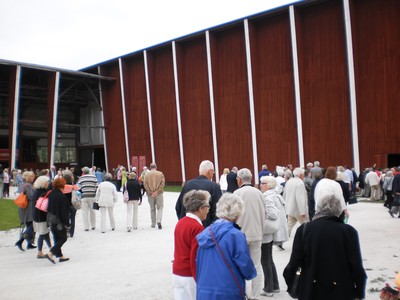
The opera was performed in the building to the right, where lumber used to be stored. The building has excellent acoustics.

The performers

The view from outside the opera house over the lake Ljusnarn.

The opera was performed in the building to the right, where lumber used to be stored. The building has excellent acoustics.

The performers

The view from outside the opera house over the lake Ljusnarn.
Pizza hos Tony med Hjalmar och Elsa
För några veckor sedan var jag med Hjalmar och Elsa och åt pizza hos Tony i Ludvika. När jag var här med bara Elsa i början av juni fick hon en hjärtformad pizza, och när Hjalmar hörde det ville han också ha det. Snälla Tony bakade hjärtformade pizzor åt båda barnen. De tyckte det var jätteroligt och lät sig väl smaka.
Pizzerian heter alltså Pizzeria Monte Carlo och ligger på Tingshusgatan i Ludvika. Rekommenderas starkt. Tonys pizzor är de godaste jag ätit i Sverige.



Jag hade ingen kamera när vi åt pizza. Tony tog bilderna med sin kamera, och jag fick dem från honom när jag var där och åt pizza igår.
Pizzerian heter alltså Pizzeria Monte Carlo och ligger på Tingshusgatan i Ludvika. Rekommenderas starkt. Tonys pizzor är de godaste jag ätit i Sverige.



Jag hade ingen kamera när vi åt pizza. Tony tog bilderna med sin kamera, och jag fick dem från honom när jag var där och åt pizza igår.
